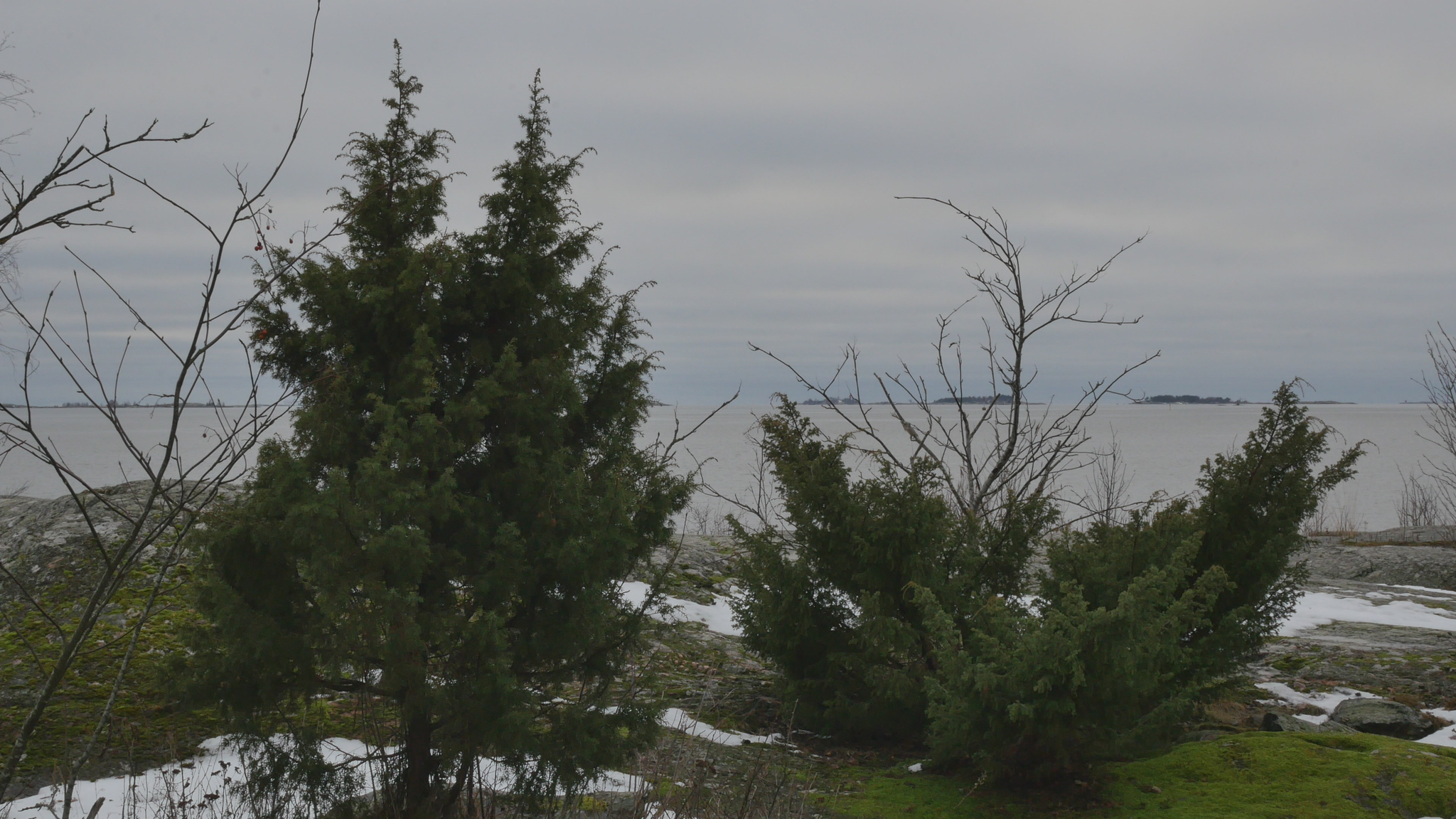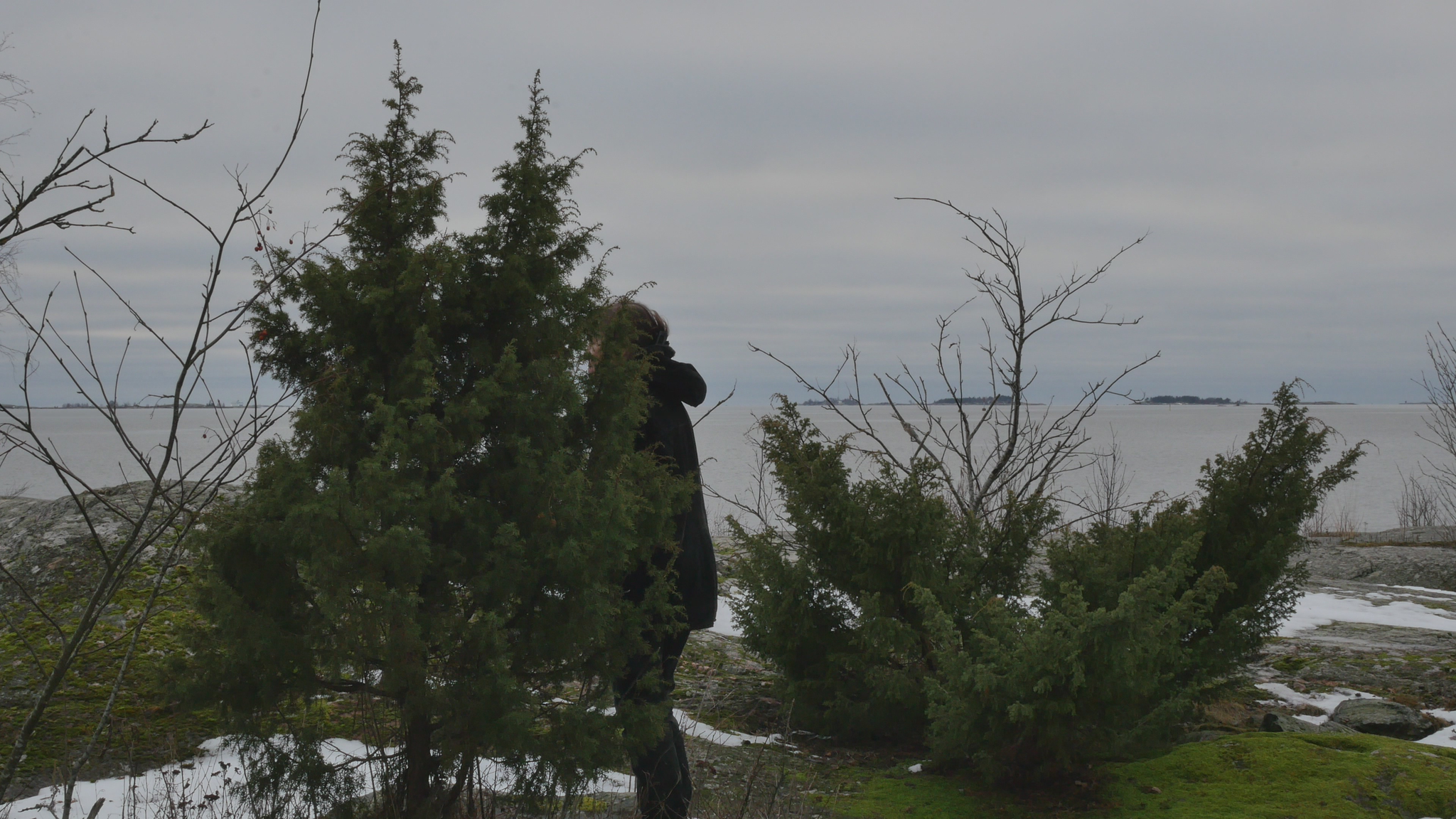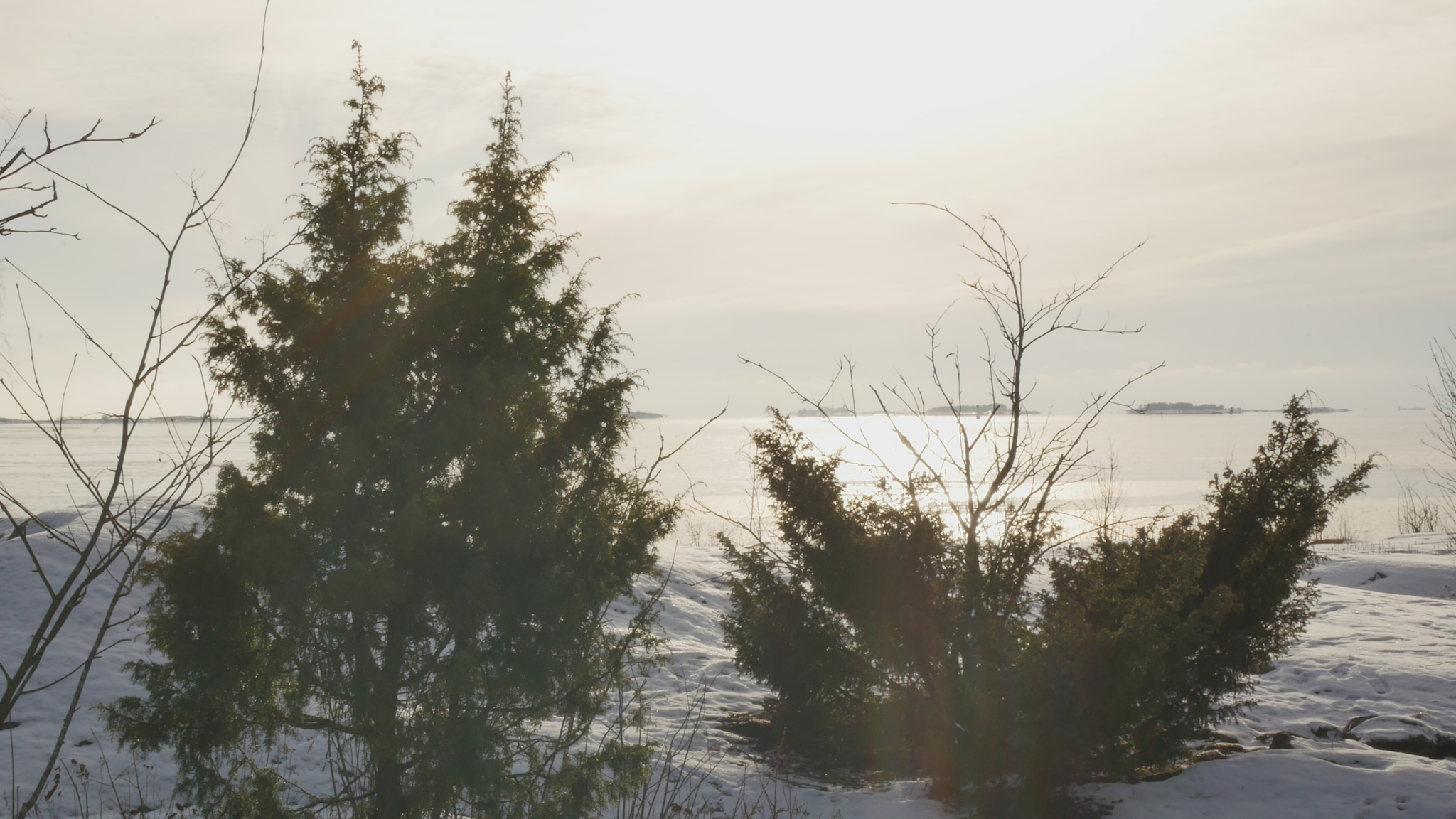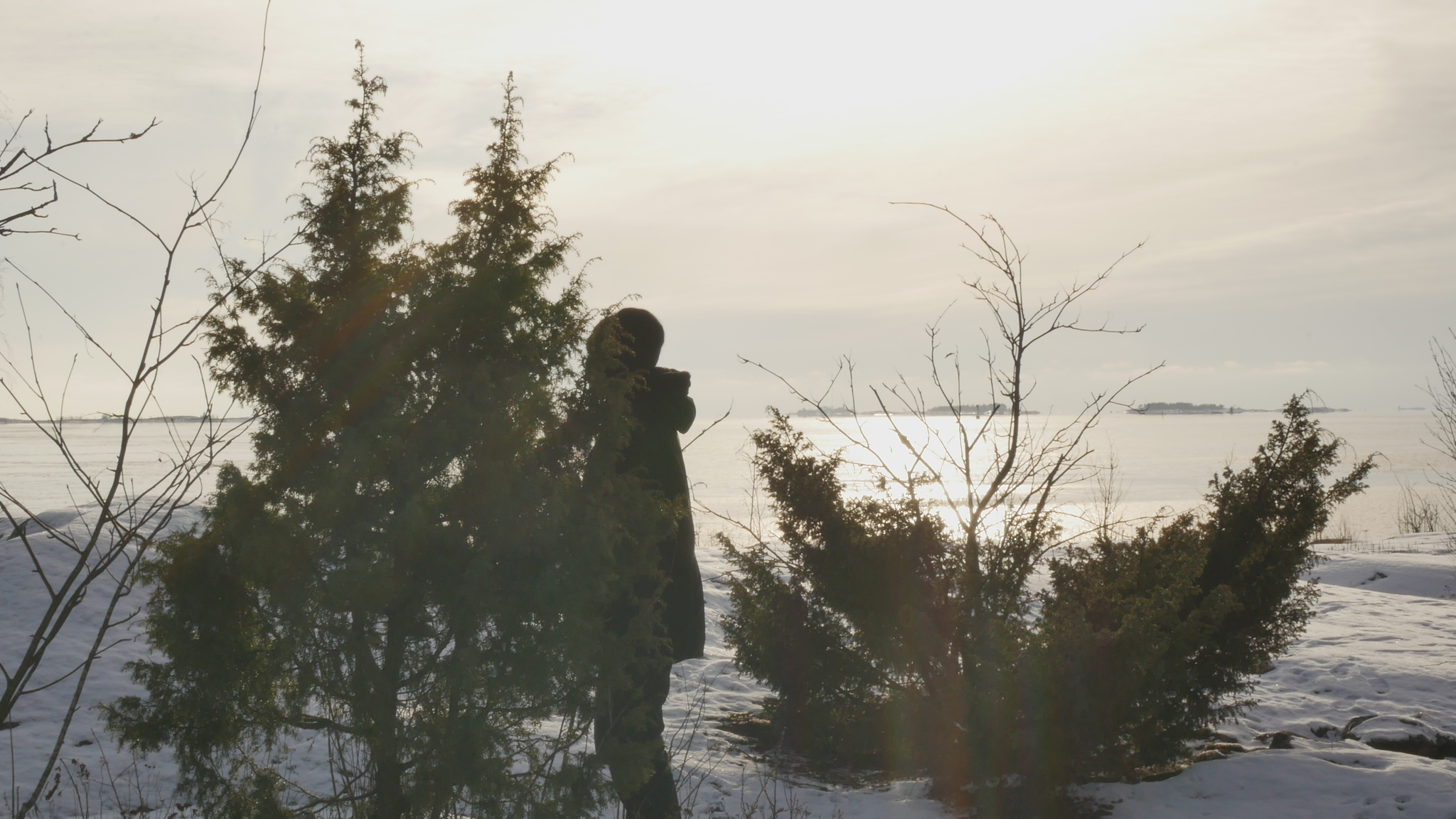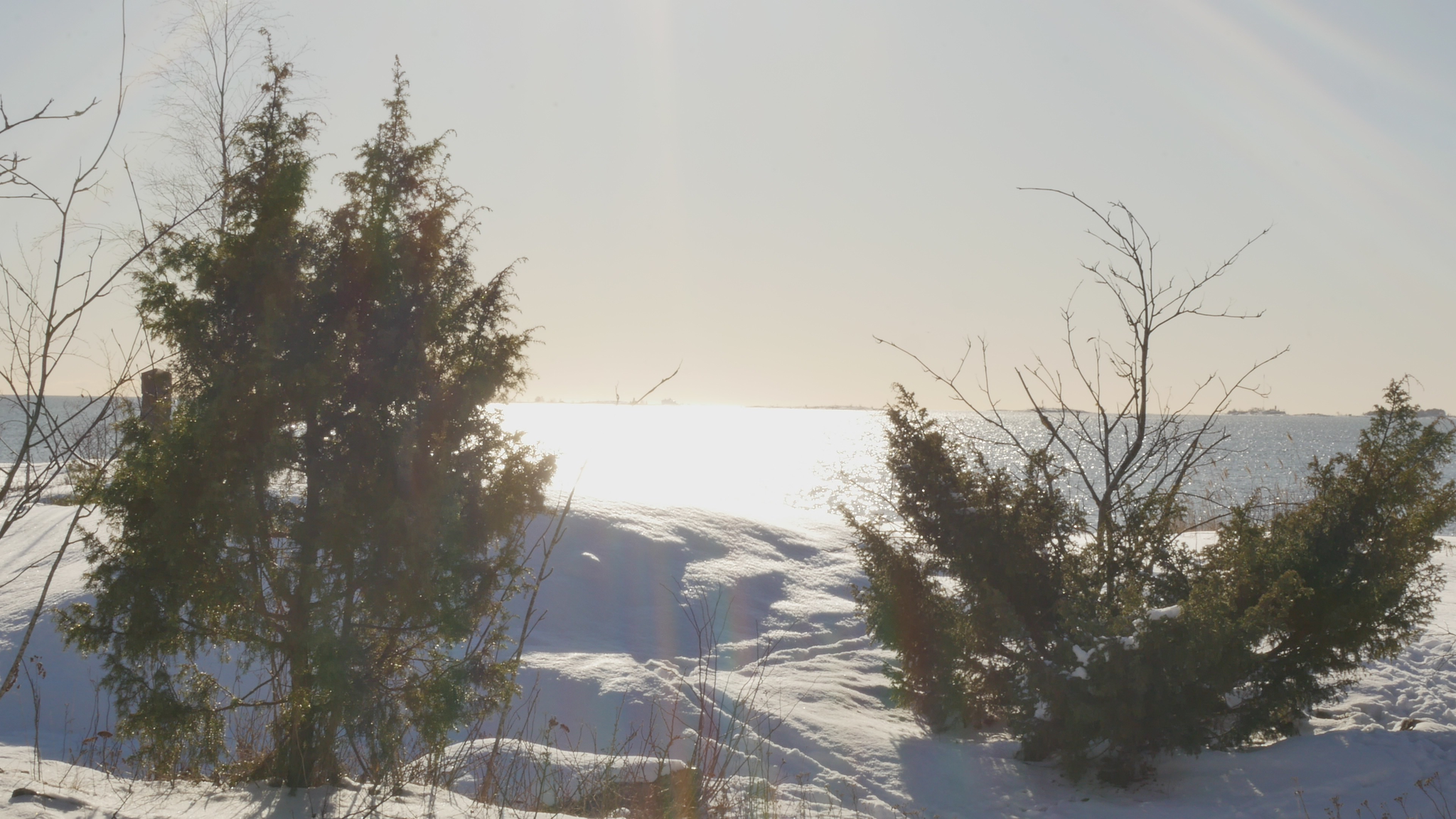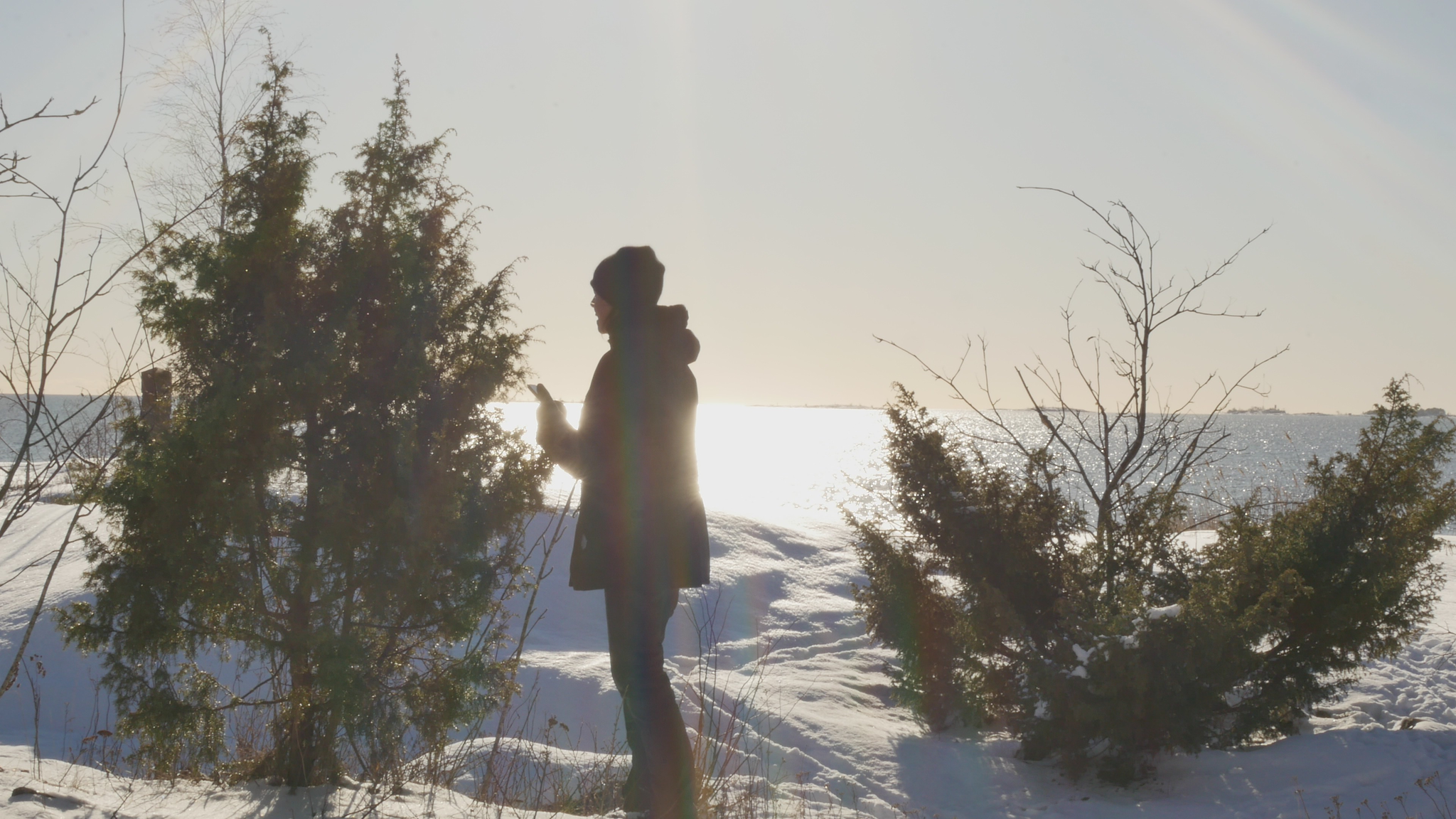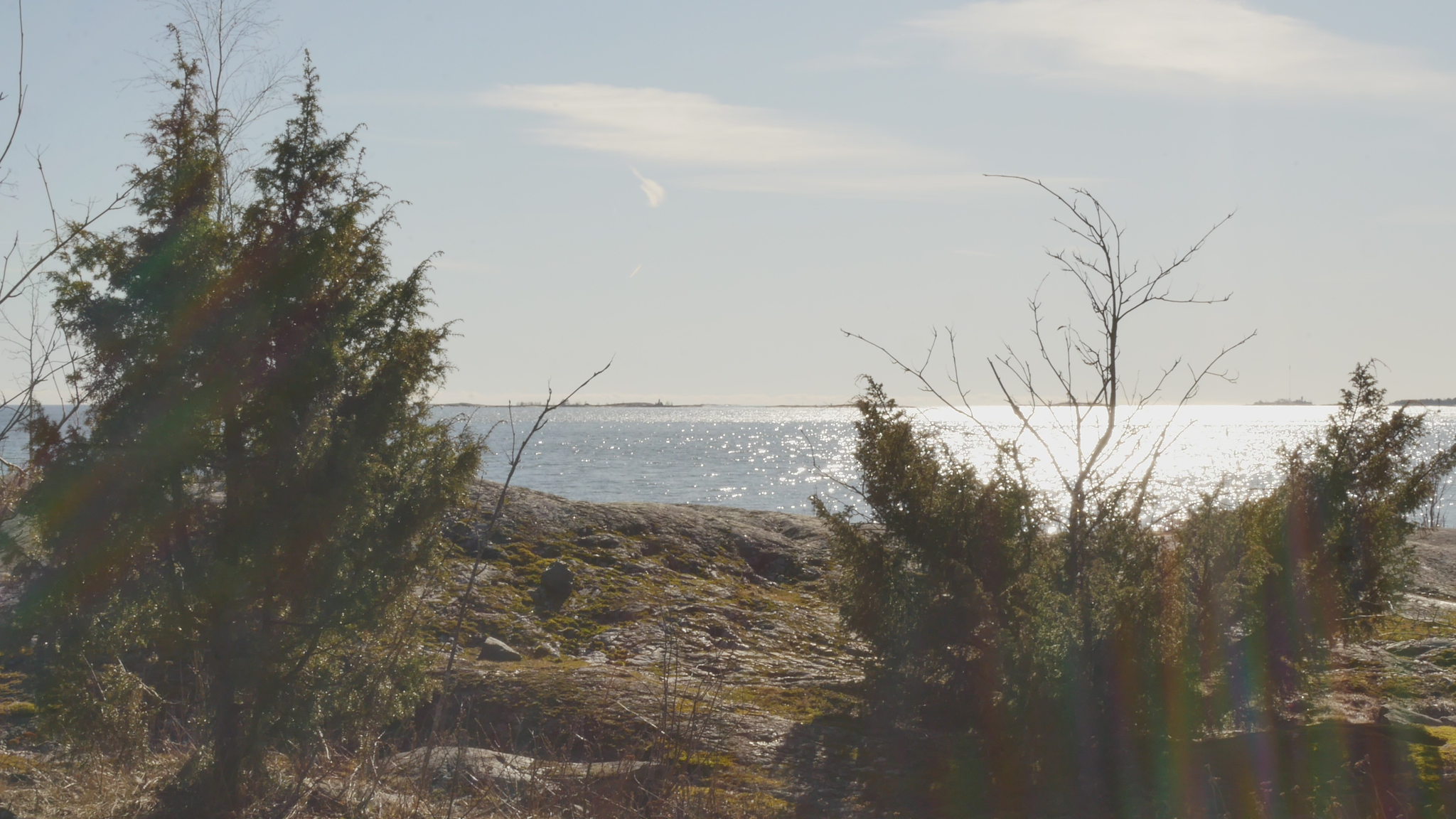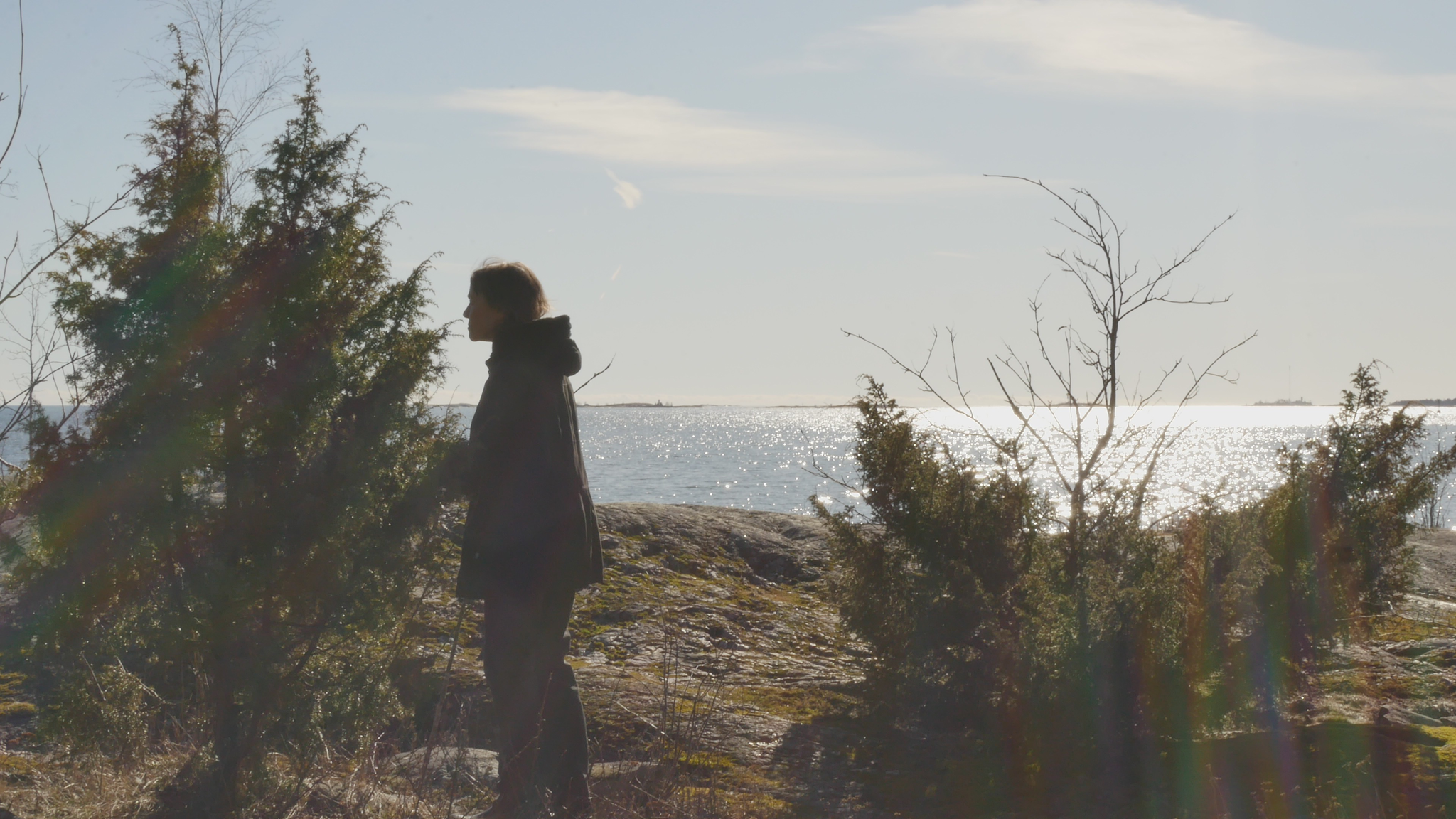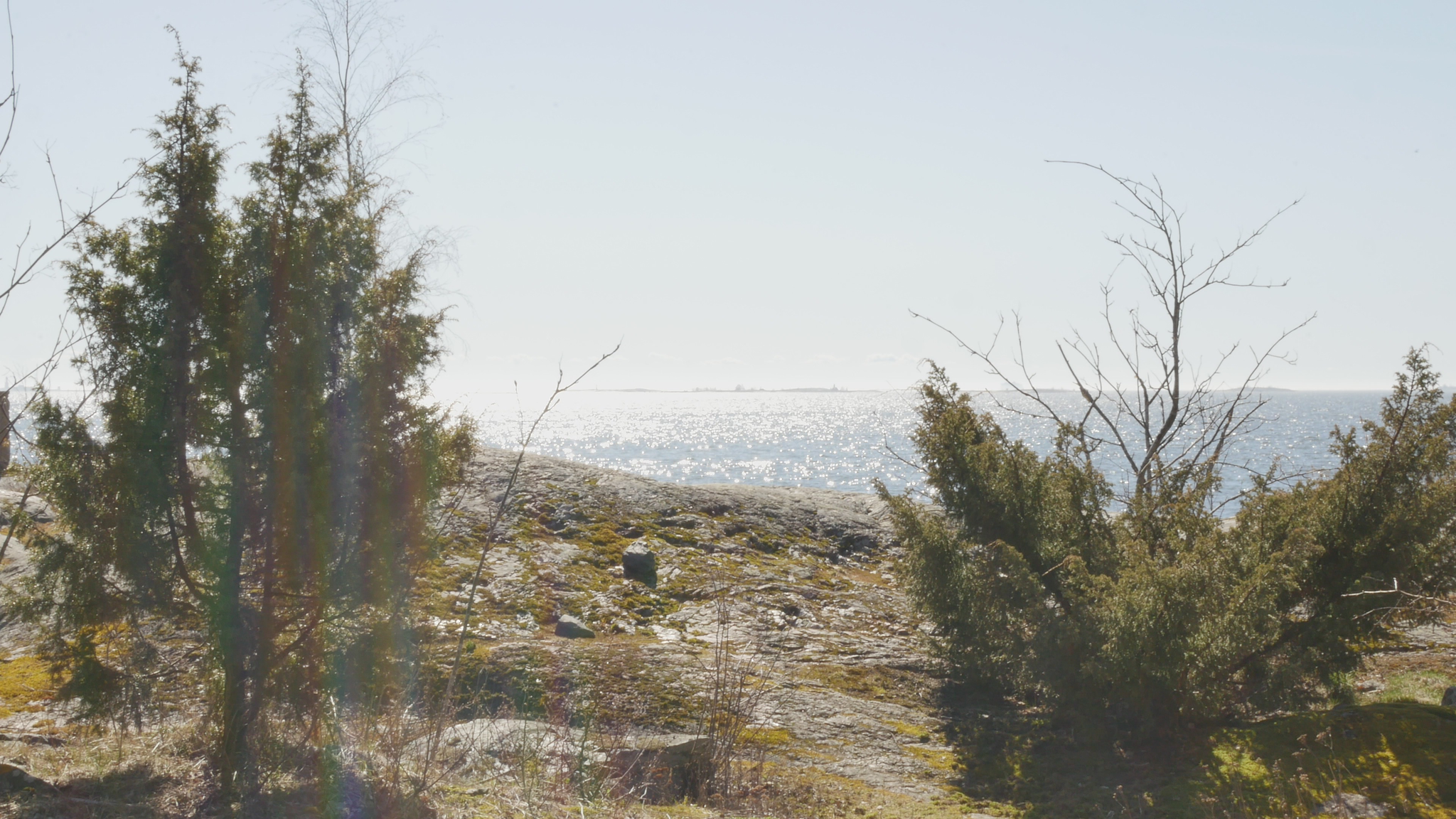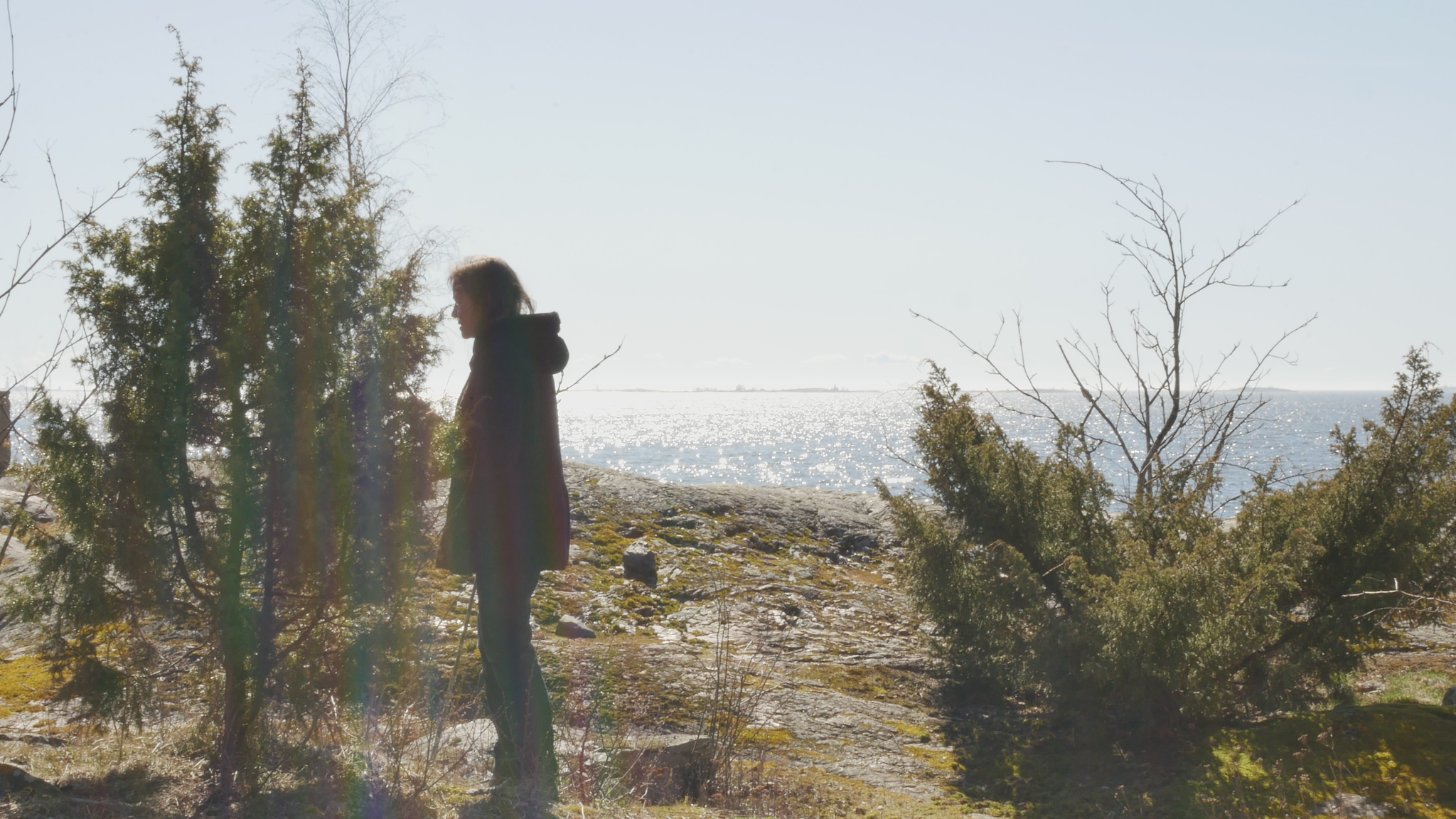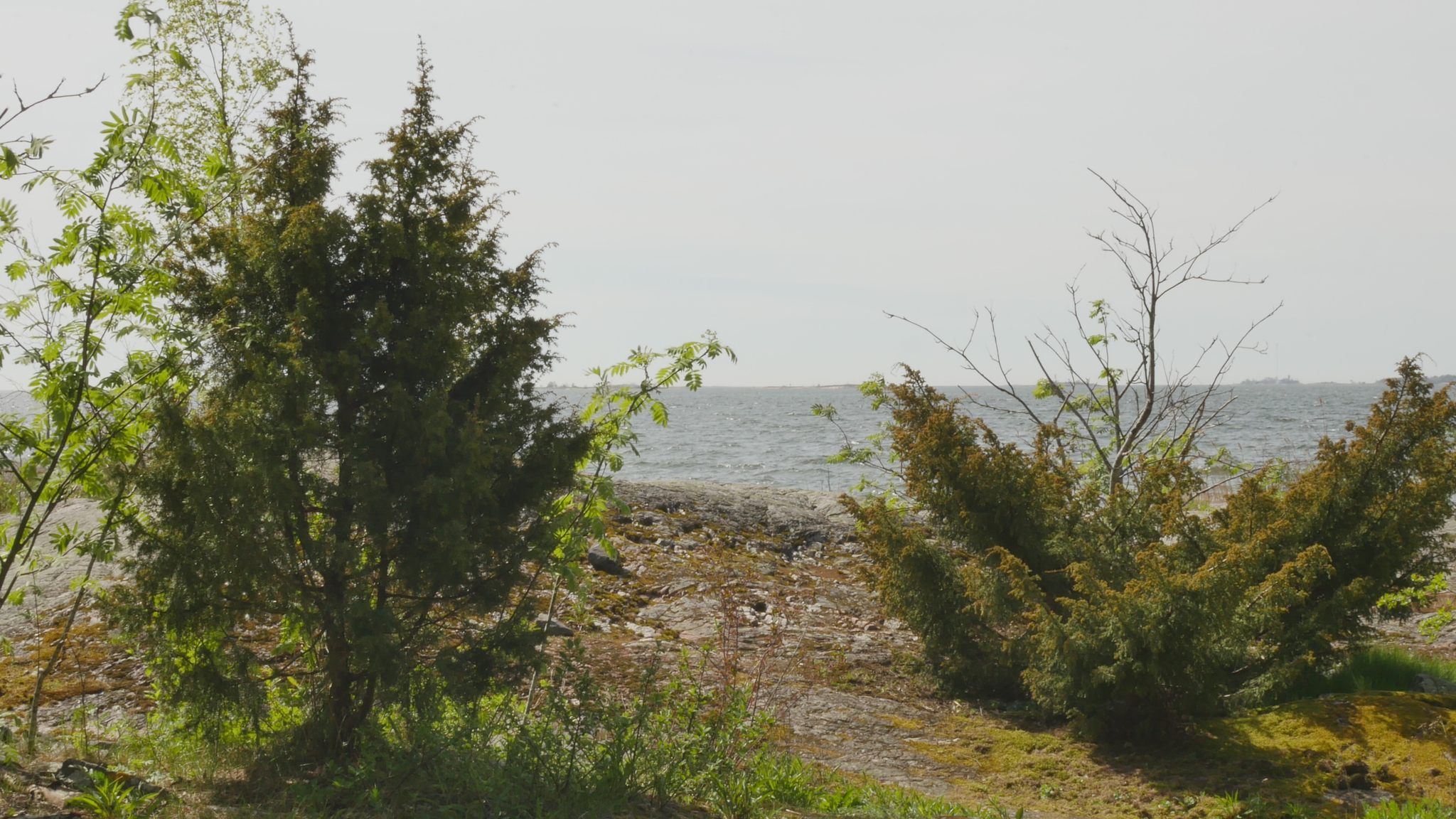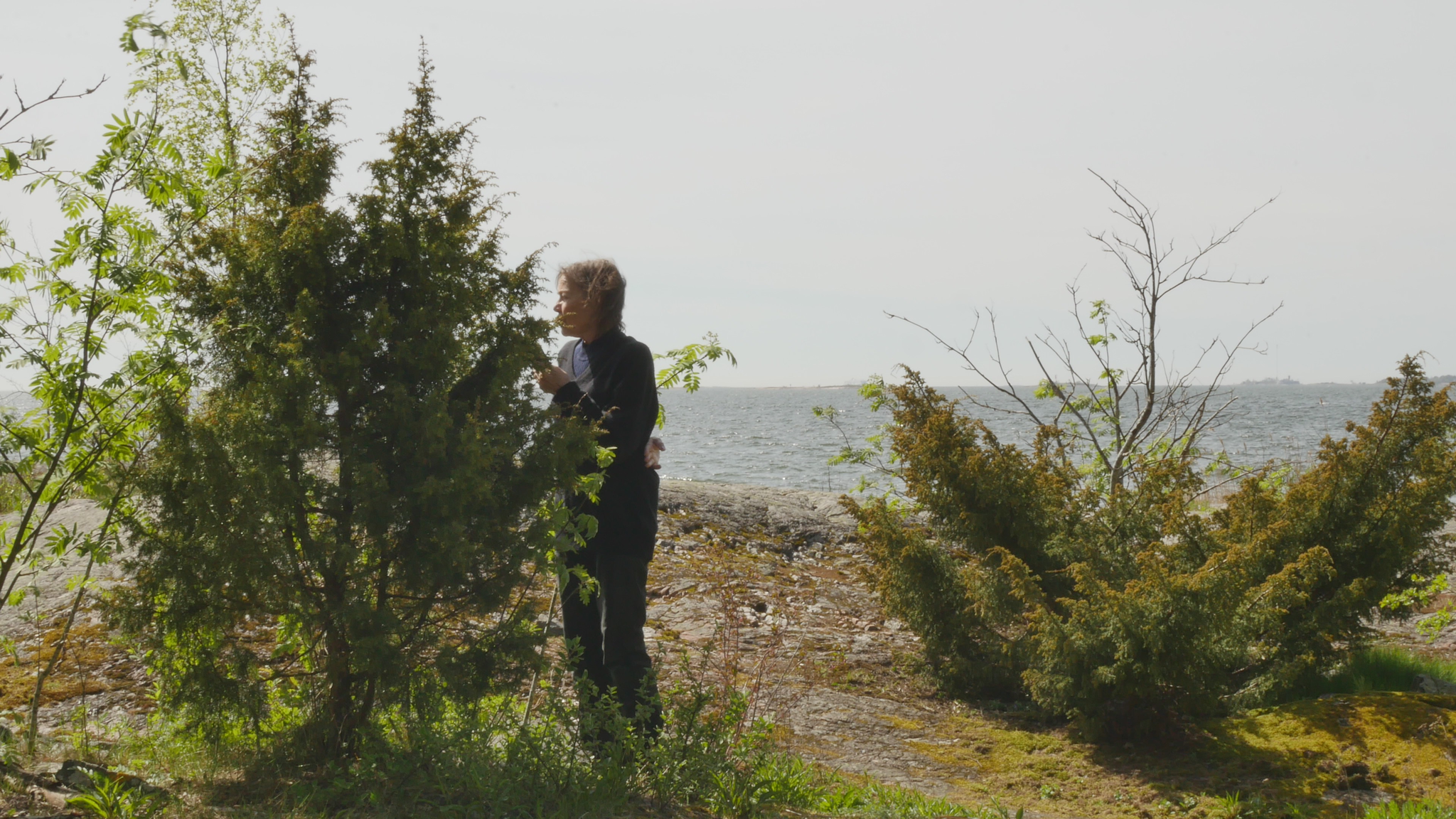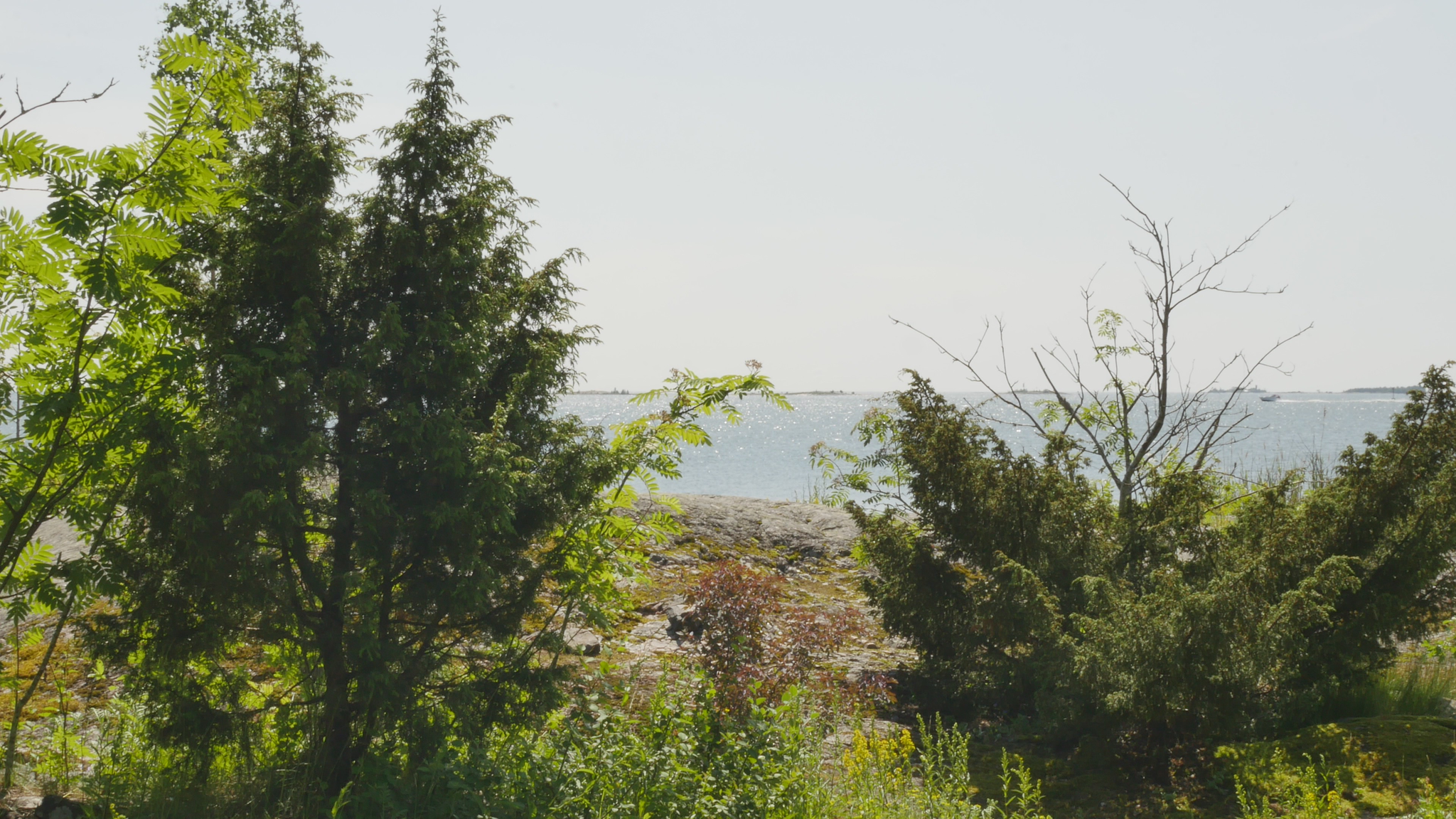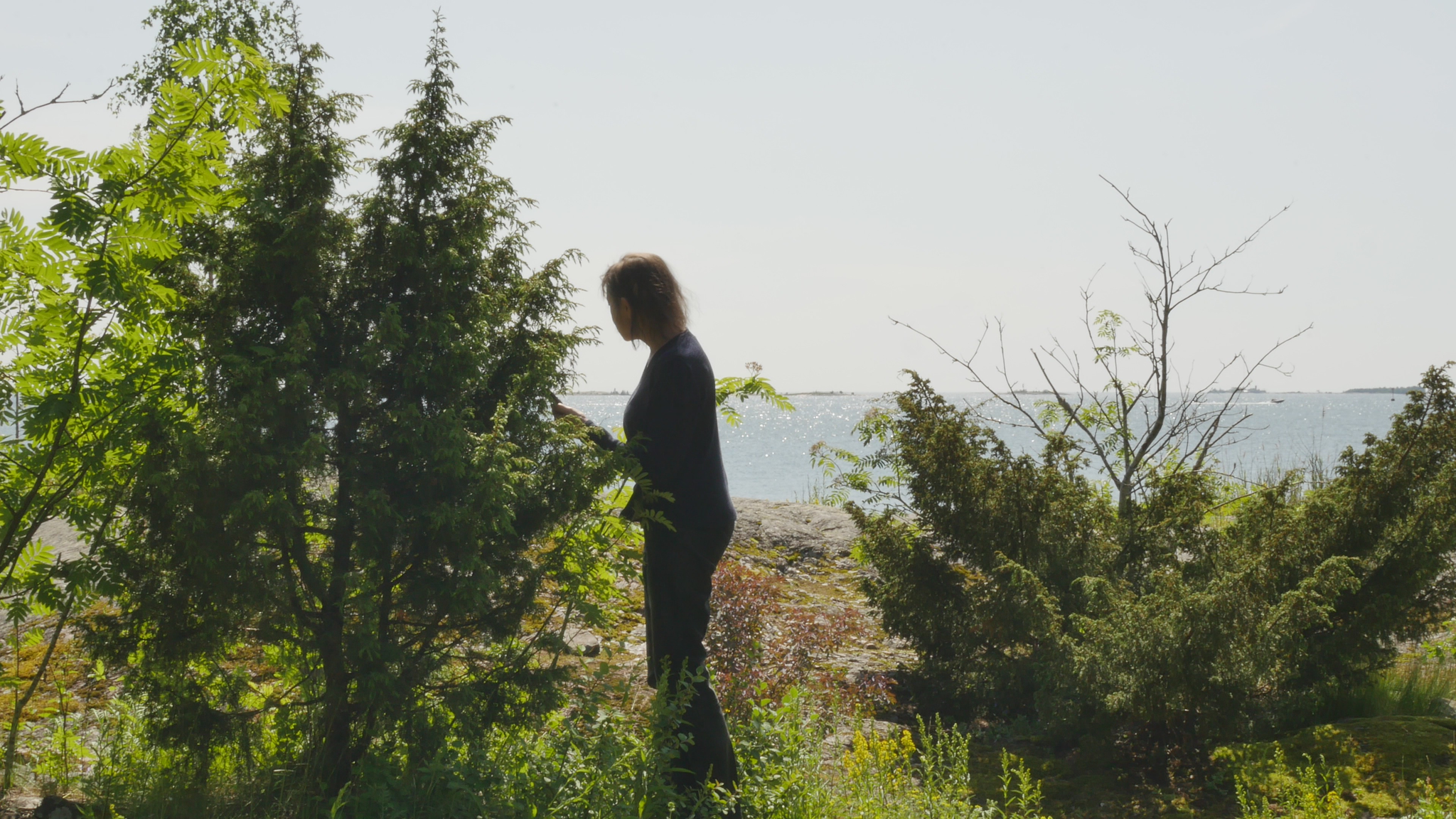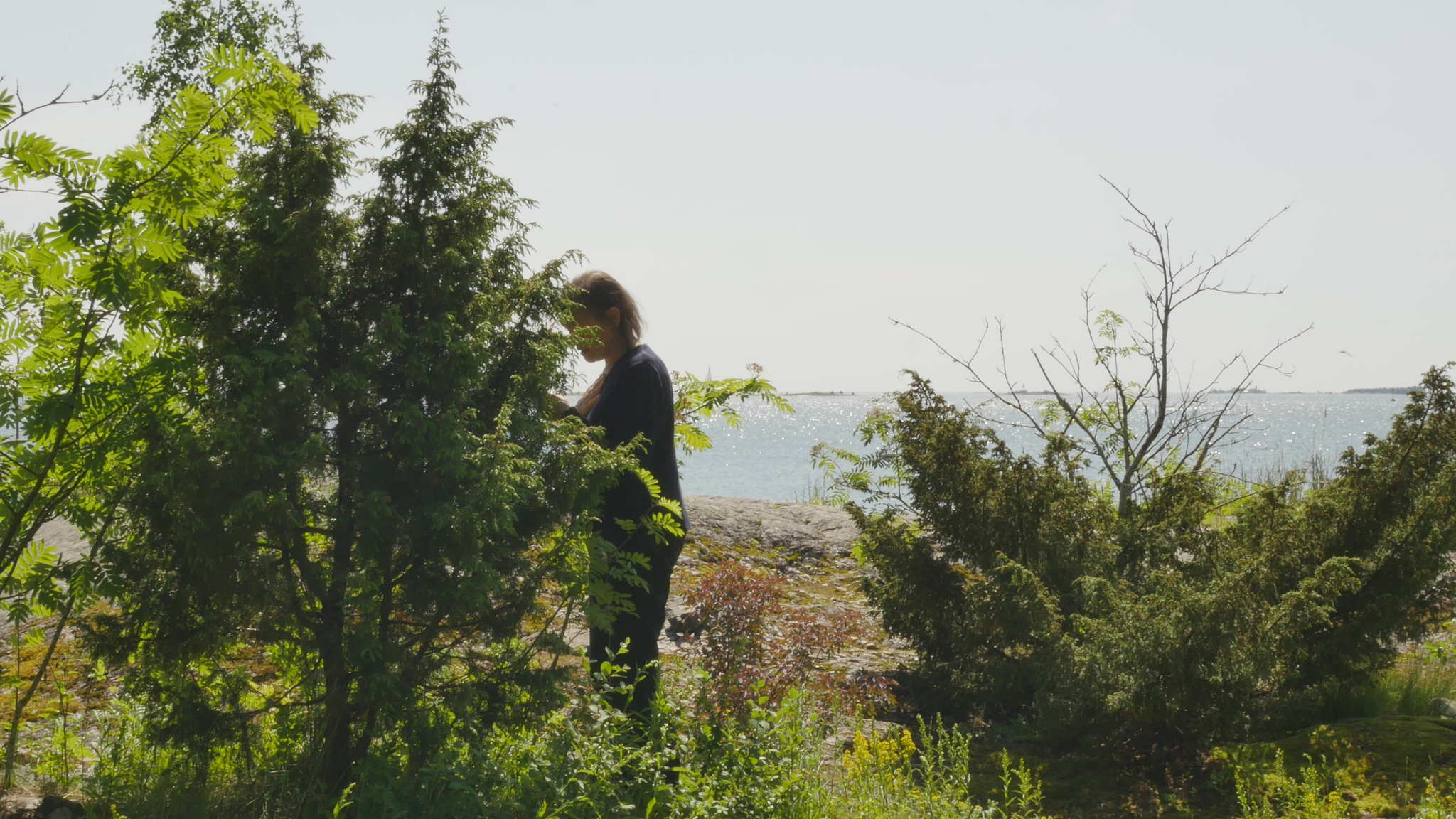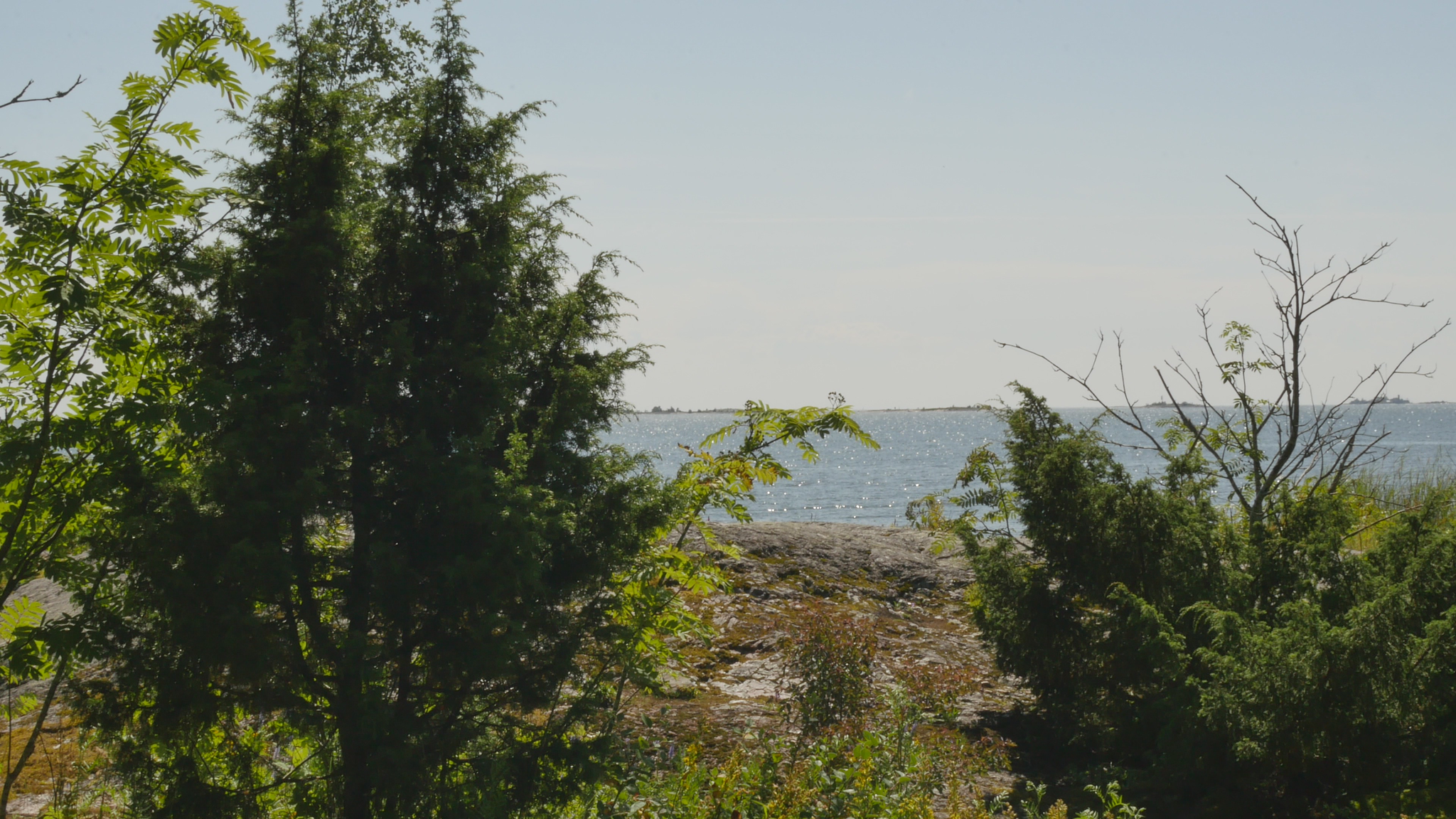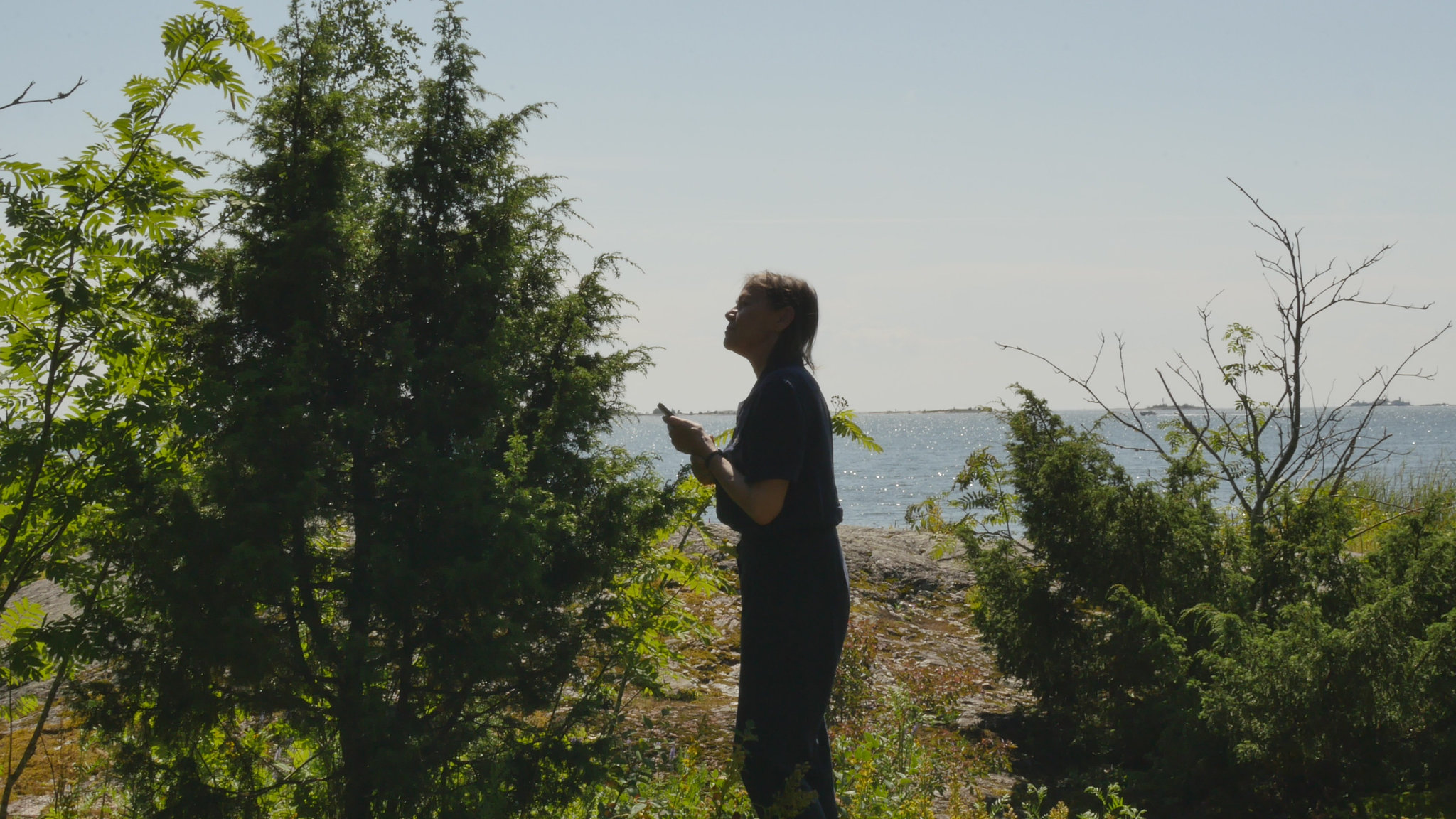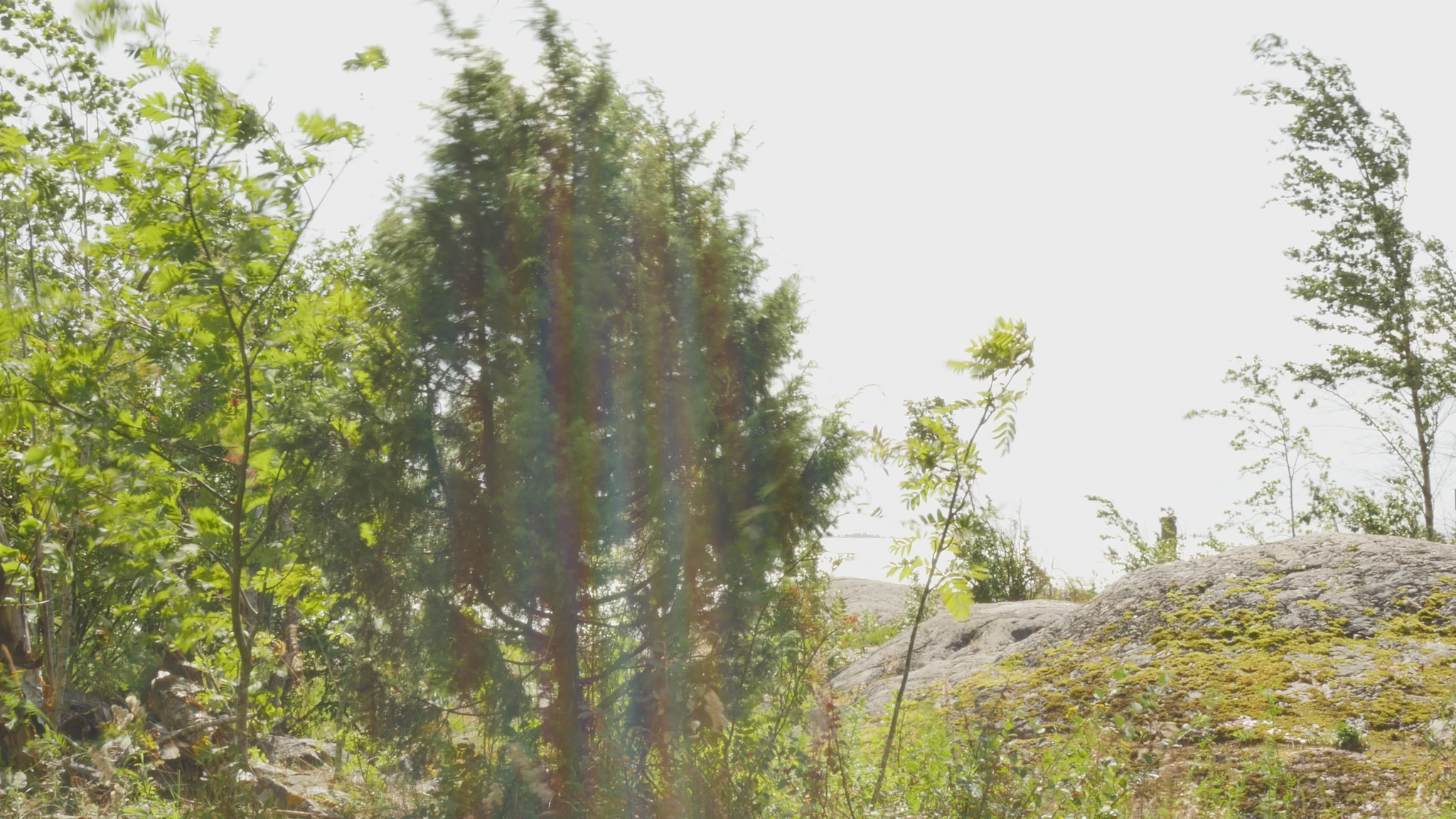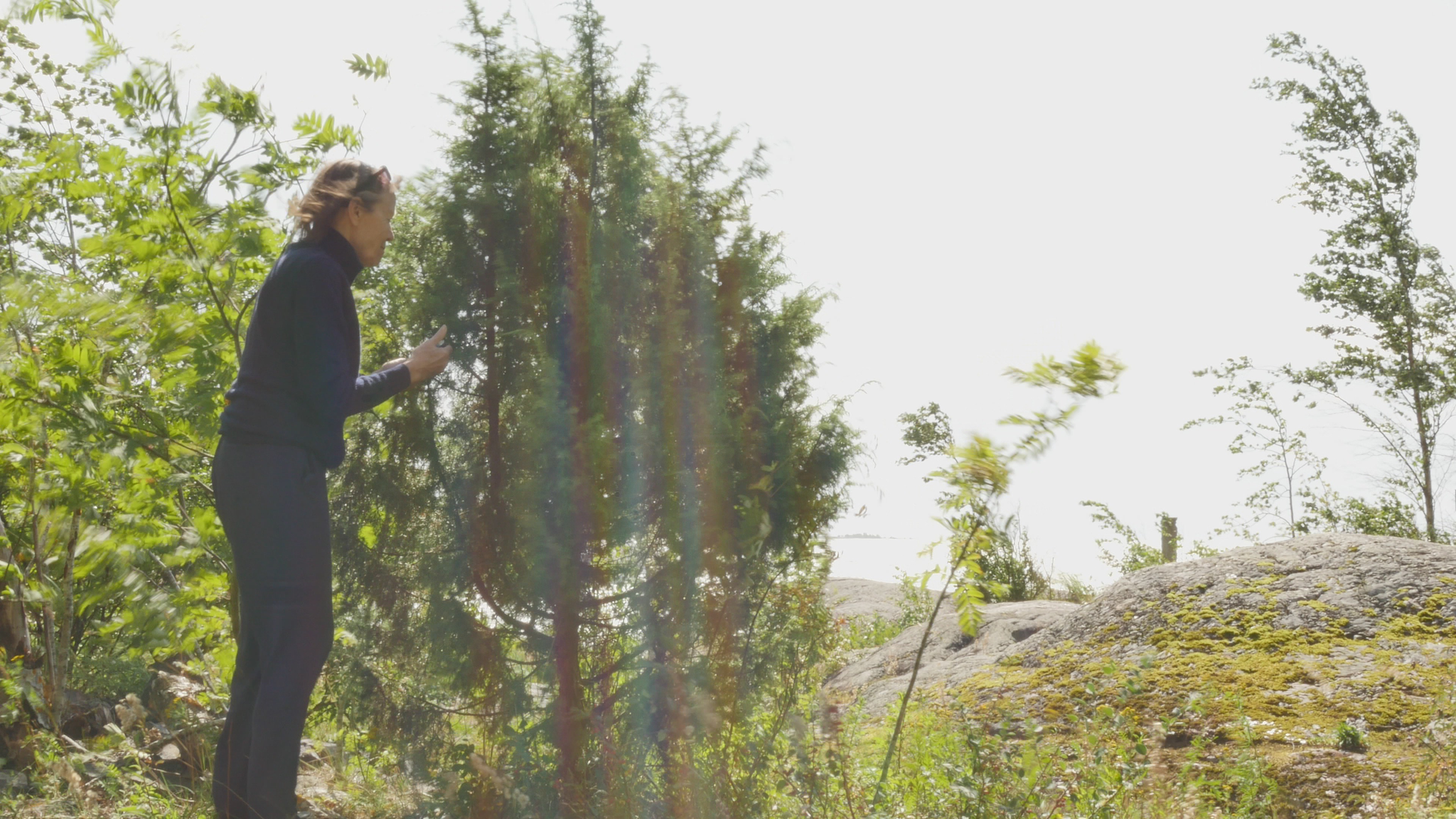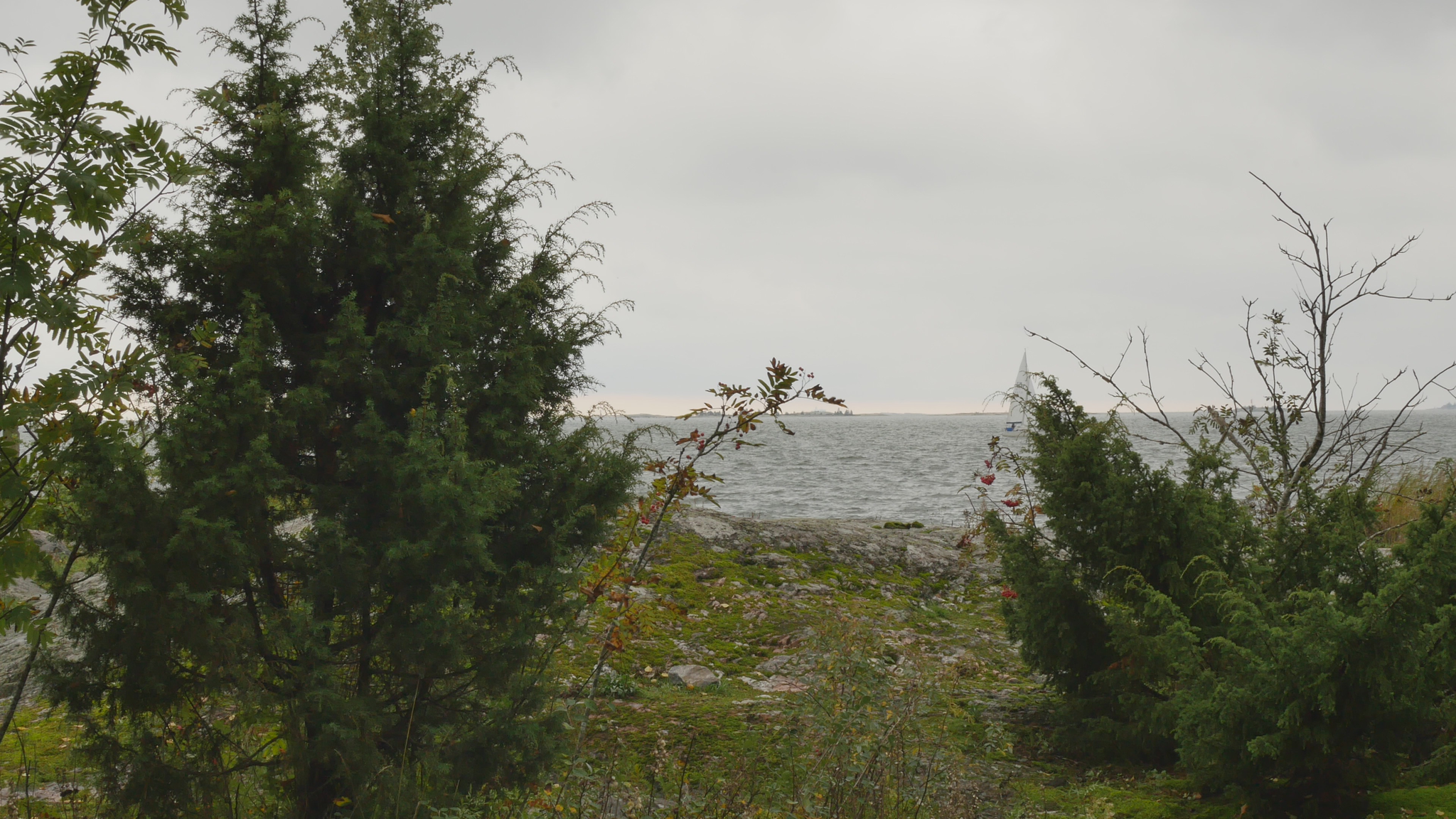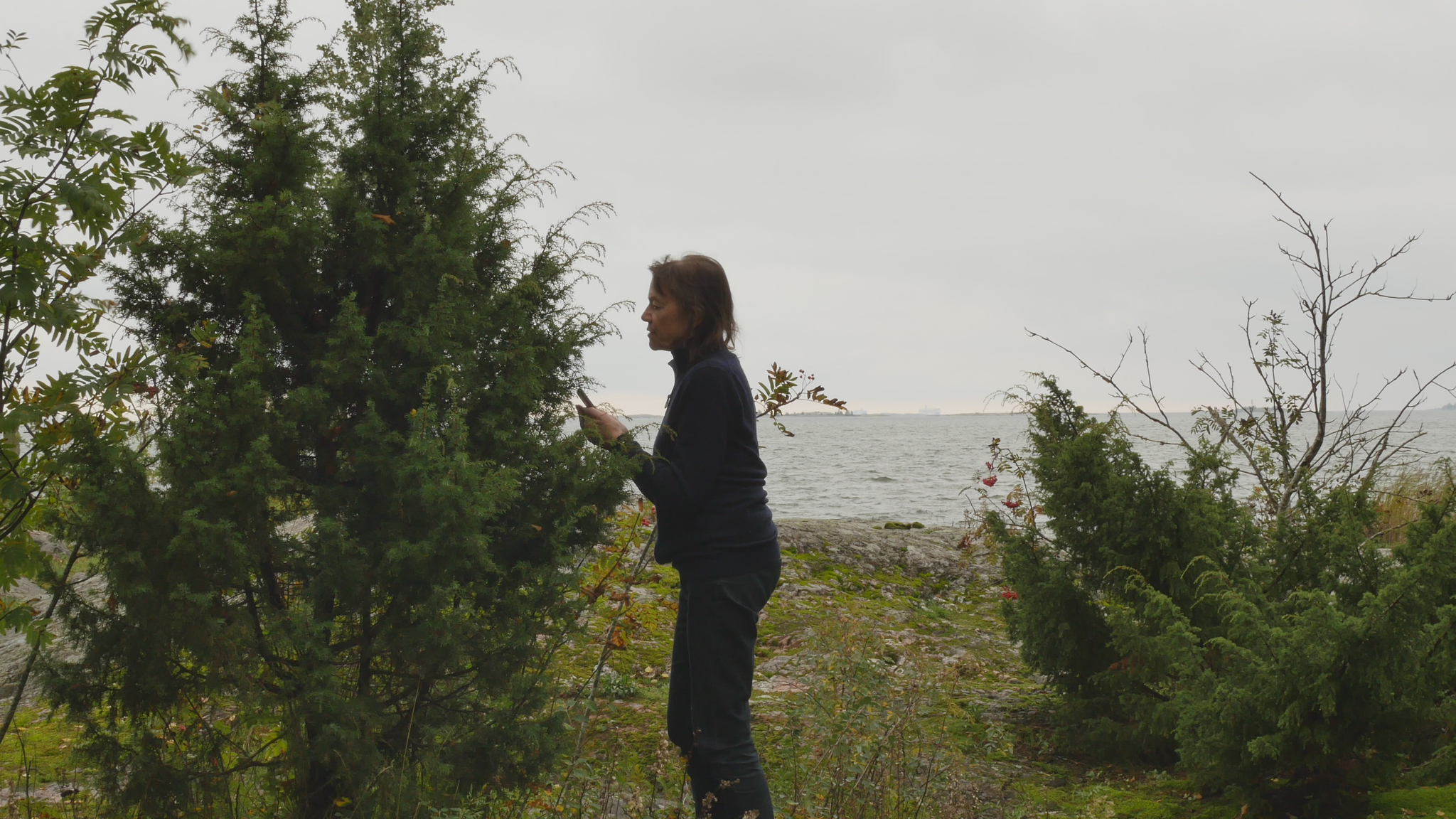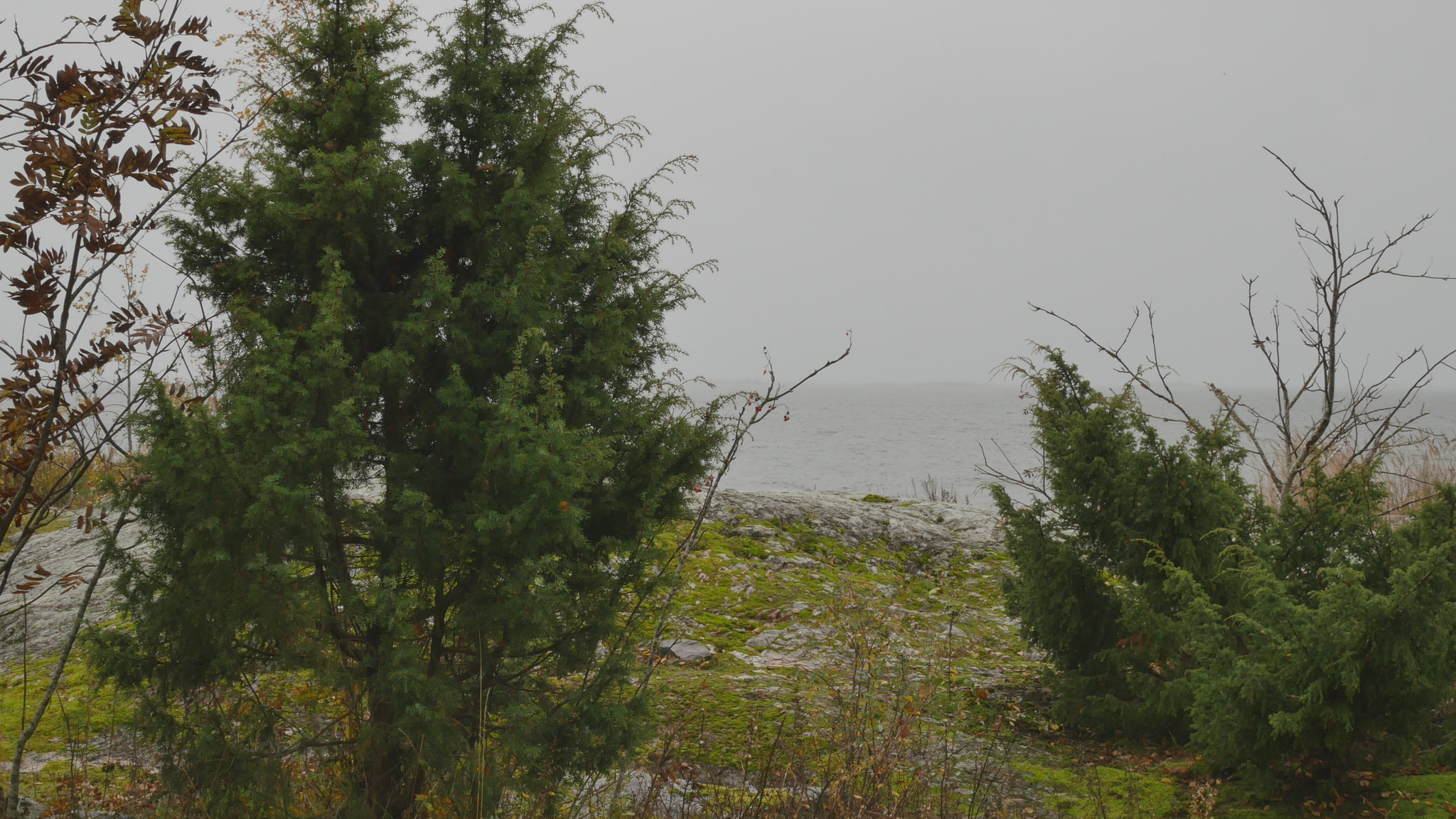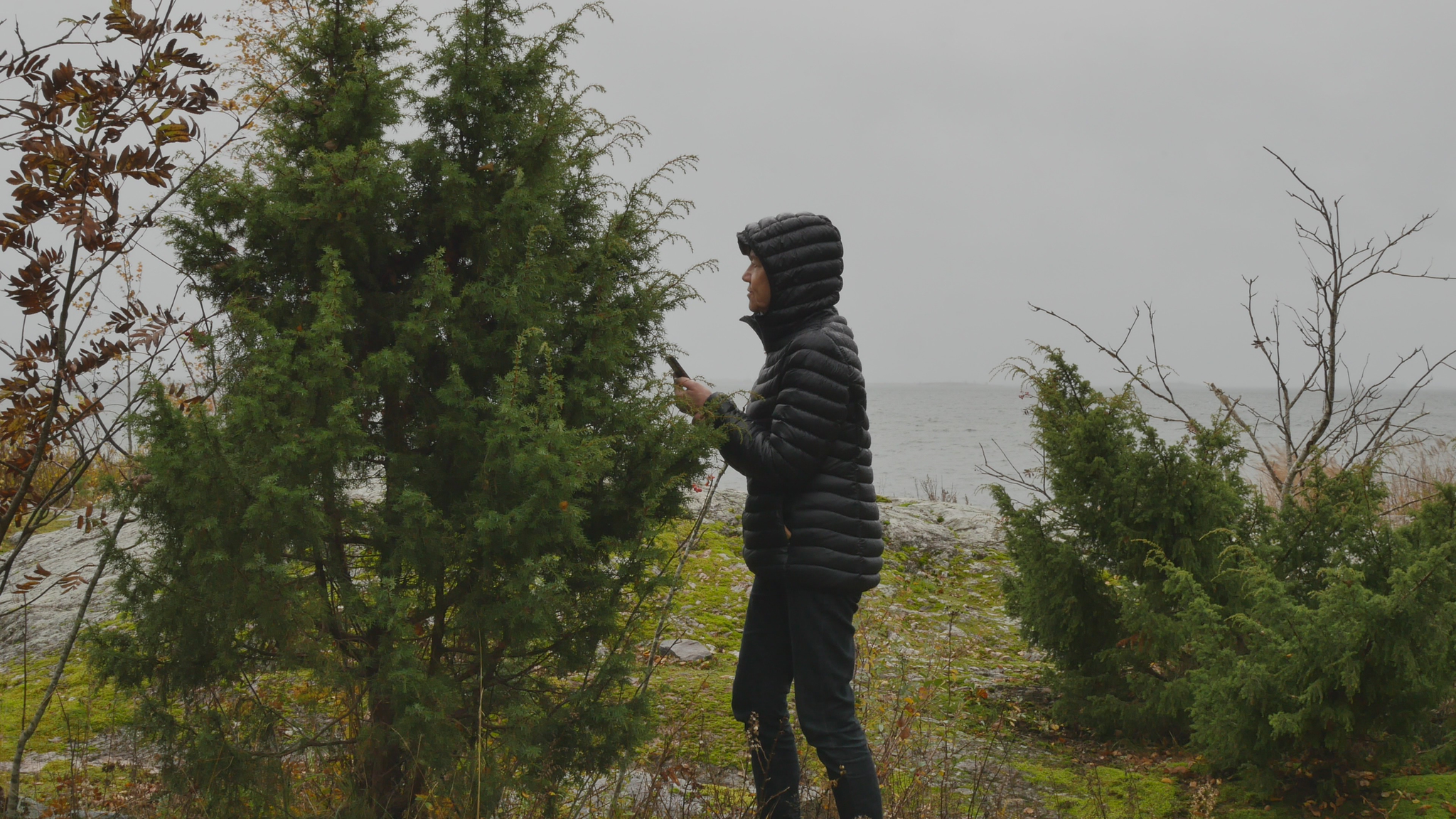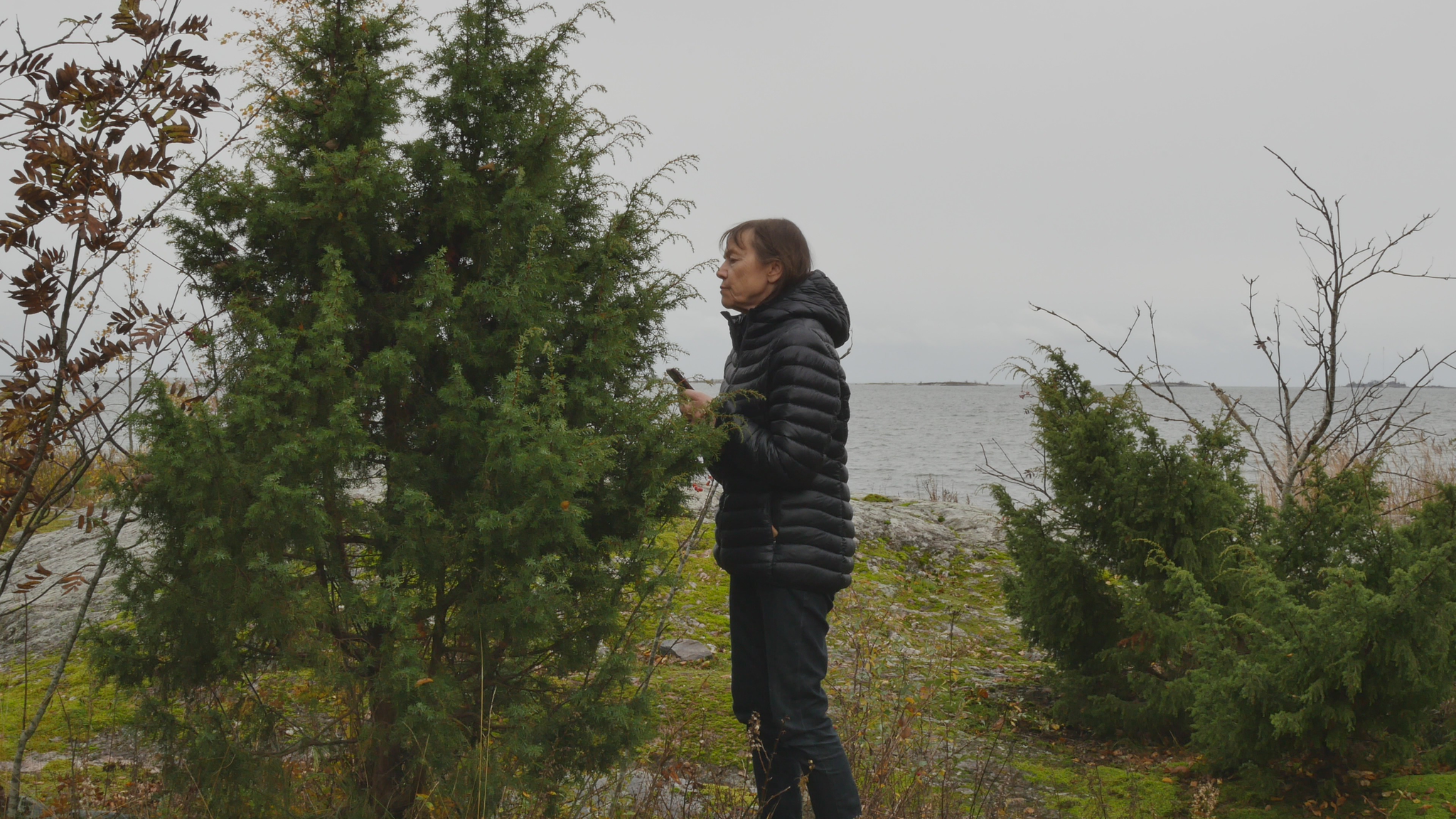Hello Juniper or esteemed Juniper, junipers, hello to you as well over there. Nice to be here for the first time recording our encounter. I was here once before Christmas and found you, so to speak, finally. I was looking all over the islands and there are not many junipers in this cluster of islands called Suomenlinna sea fortress. We are right now on the north-western most island, the one closest to the mainland but also closest to Harakka Island where I usually work and have my studio since many years, which was originally part of this sea fortress as well. When I came here before Christmas to look for junipers, I found one towards the South or south-east near the old submarine boat that is there on the shore, but in a place that was not accessible. And then I found a small juniper right next to the road on the very southernmost island. But finding you here, there's actually three of you growing nearby on this north-western island, which is called I think Länsi Mustasaari, the western black island, was a very nice encounter, because you are here somewhat secluded or in the tranquil place and very, very beautiful. So, I hope you don't mind, or I'm asking for your consent to come and visit you every now and then or maybe approximately once a month and to try to talk with you or have a conversation with you and even touch you as I do now, holding on to a branch of yours.
I have been working with junipers before more than ten years ago and at that time I was often holding on the junipers, but I was covered in a green scarf and that was very different. I was not trying to talk with you at all. And that is what I'm trying to do this time and to learn more about you. The reason why I came here to the sea fortress is because I hope to find studio here, to be able to rent a small working space here next year. Because I have to leave my studio on Harakka, and because Suomenlinna is sort of the mother island of Harakka, too, in ancient times at least. It felt somehow natural to come here because I want to be by the sea. But I've been also talking a lot with pine trees and in some sense pine trees are of course very, very beautiful and exciting, but I always when I worked with you, junipers, I always thought you were very special. One reason is maybe because my grandmother, my mother's mother loved junipers. And in the garden or in the area around the cottage in the countryside we were never allowed to cut down any junipers so there's plenty of old and young and small junipers growing all around the house, I think. There is a lot of mythological knowledge about junipers also in in Finnish folklore, but globally in different cultures. And I read some of it on the ferry coming here. And there was one detail that I remember, which I thought was funny, which was this idea that if you were to pick juniper berries you should remove your hat or your cap. And of course, removing your cap is a sign of respect so maybe that was thought of as a sign of respect, too. I don't see any berries on you, so I suppose you are a male juniper because the junipers are either male or female. And I guess the female ones have berries but sometimes also the form is different. So, you're more upright so you could be a male one also based on the form, whereas your neighbour nearby, closer to the sea, is more like spread out and it could be a female one. But that is not always correct because I met a juniper in Stockholm, and it was very tall, but it had berries. Now I say it because in finish we can say ‘se’ even of human being, so it doesn't mean that I think you're dead or an object if I call you an ‘it’. But in English maybe I should say you, they, or he, maybe you are he, I don't know. Today it's a very beautiful day to begin these conversations because there is almost no wind so this recording is not disturbed by the sound of the wind. I don't have so much to tell you yet so it's more like getting to know you a little bit. I also stand sort of partly behind you because here you have a small branch that I can easily hold onto even though it's very small so it's not really for support. I can see that your trunk is substantial so you're not a youngster even though you're not that tall. But I guess this is also not a very easy place to live in because normally you would have quite a lot of wind here on the cliffs. B I also know that junipers are very strong and resilient and can live in harsh circumstances. So yeah, I respect you for that. And in many cultures, you're the symbol of both death and rebirth. I don't think in Finnish folklore, it's not necessary that, but the smoke from your branches is used for cleaning purposes, also cleaning sort of spiritual cleaning. I've never experienced that, but they say that you can make like a ‘vihta’, what we usually, a broom out of Birch leaves, which we use to clean ourselves with in the Sauna. That you can make a broom out of juniper branches and have your aroma in the sauna, but with your sharp small needles using you for sort of brushing myself with, well, that's probably not very pleasant. But I thought I'd ask permission from you to take a small branch of you or maybe two, to put on my door, because that will protect the house from evil spirits and witches and so on. And then maybe another small branch to try to see if I could burn it to get some smoke to clean inside the house. I will try to take the branches from down on you, so not from the top branches and I hope it doesn't hurt too much. I'm very grateful and I realise it's quite rude to take something from you already during this our first meeting. But I thought it would be also a symbol so I could carry you with me in some way. And for the next meeting I will try to find something I could give you as a gift in exchange, but at the moment I don't have anything with me. I apologise for that. Anyway, thank you for this first encounter and I look forward to our next meeting, and yes thank you, thank you. And take care.
Hello dear Juniper, nice to see you again on this cold sunny Sunday afternoon. I didn't realise that the sun will shine directly on the camera at this time of the day so now I know I should come to you earlier, although of course the location of the sun will change later in spring. Now the winter is finally here. January was exceptionally warm, and it felt like there would be no winter at all, but now it's cold. It's not exceptionally cold at all but because of the warm January it feels colder. It's maybe -10 or now in the sun maybe -8 but the sea is slowly freezing. The small bay here in the Western Black Island or how you translate the name Länsi-Mustasaari is already frozen, but of course the open sea is open. I have not visited Suomenlinna Sea Fortress since we last met in January and not done anything to advance my finding a studio here. But I've looked at the website and no, there are no empty studios at the moment. I also I thought about talking with you about the text I more or less happened to read last night, a short polemical article. I don’t remember the exact title but something like Sustainable Art Should not be Placed in Nature [Sustainable art should not be installed at natural sites] by Riccardo Guiano [Guarino] or something like that, I don't know the writer. And he was very critical about art being placed in natural environments and in natural parks and well, anywhere in nature and especially on spectacular sites. Partly because they might do some harm to the local ecosystems but especially because they foster sort of a consumerist attitude to nature, and instead of an appreciation of nature for its own sake and its slow processes and so on. And that makes sense of course. He has a lot of examples from Christo’s huge packaging efforts to Andy Goldsworthy’s small very subtle and you would imagine very ecological works created of natural materials that will then melt into the surroundings, like leaves or materials from nature. But of course, this idea of also inviting people to go to, in large amounts, to spectacular sights to witness some strange sculpture or bench or frame there, it’s in a way not such a good idea. The only works that he somehow accepts or mentions as positive examples are by Agnes Denes, the classic work the Wheatfield in New York, but also the Tree Mountain, which is in Ylöjärvi in Finland, where a huge amount [number] of trees were planted on a site where they had taken gravel or other minerals and sort of, so the planting of the trees was like a restoration project. And of course, that's something beautiful to think that art could be both aesthetically interesting and restoring some damaged environments, and there is quite a lot of such things done. But of course, I then also thought about what we're doing here together, our so-called collaboration when I come and visit you and make images and sound works out of our encounter. Of course, I'm not doing much damage to the site; I triy to tread carefully although I'm trampling the plants where I stand. And I'm not inviting huge amounts of people to assemble here and destroy the surroundings. And anyway, this is an area, a public parc as part of Helsinki where people come anyway in masses and destroy the environment even without any art as an excuse. But the challenge of how to collaborate in a manner that would be beneficial for you, too, that is a constant problem. And I haven't been able to solve that in my previous experiments. And to be honest I don't expect to be able to solve that now either. But even though the text was provocative and as an artist I felt it was like accusing artists for [of] being hypocrites and claiming that the damage they do is counterbalanced with the positive interest that they evoke in people towards nature and so on. His condemnation was quite harsh but in a way to some extent I agree. So, it's not, a lot of so-called environmental art where you do stuff out in nature and then leave the materials there to rot and to participate in the natural life cycles; well sometimes they feel almost like litter. And I agree with that even though there are some very beautiful works, too. And I've never been really, I've never felt like I would like to place something in nature, to sort of create a work that would participate in the natural environment. I'm always taking away things from you. It's almost like picking berries or mushrooms and I'm collecting images and then I make my cakes or pies with them and hope that somebody might eat them. And I'm not saying it's in any way a more sustainable way of doing art, but it's nevertheless, it's different. So, I understand his criticism although as an artist I'd like to defend the artists who want to work out in nature and sort of show their love to their surroundings in that manner. I don't know if it's really, I don't know if I can say that I feel love towards you; we hardly know each other. But I'm I'm really curious about you and I would love to be able to initiate a more reciprocal relationship with you. But as I said before I haven't yet found a proper way to do that. In any case I'm very grateful that you allow me to spend time with you. And somehow, I imagine – and now it's of course a risk that I do imagine – but I imagine that you don't mind me standing here breathing some carbon dioxide on your needles or, well, making sounds that you might distinguish. I do appreciate your generosity and I wish you a really nice rest of February and beginning of March and enjoy the light that will now increase. And take care.
Hello dear Juniper, great to see you again. Now it's a cold sunny Sunday, 16th of February, and the sun is shining right in the ‘eyes’ of the camera so to speak. I will talk to you only briefly because it's cold. And for some reason the camera doesn't like the cold now. But I guess you like it somehow; you look fresh and like you're doing fine. It's amazing actually. January was so very warm that I didn't believe there would be any proper winter, but now after that warm January this feels really cold, although it's only -10 or maybe -8 now in the afternoon. I haven't done anything for, to promote my project of finding a studio on this island, but I've looked at the website and there are no empty studios at the moment. But I'm looking forward to the idea of a new studio. It's a new start in some way, when you have to clean away all of the old stuff. But I tried to talk with you about, or planned to talk with you about, but I don't know if there is time because I want to make this short, is a text that I happened to read last night, by Riccardo Gujano [Guarini], I don't remember the name properly but, a text about sustainable art that should not be placed in nature. And it was a provocative text but somehow also reasonable. Because there is a lot of art, so-called environmental art, which is sort of spectacular gestures put in spectacular places that according to him don’t foster any love for nature but more a consumerist attitude towards spectacular views and so on. And the only artworks that he would somehow accept would be environmental artworks that would include some restoration aspect with them, like Tree Mountain by Agnes Denes in Ylöjärvi, which was planted on a disturbed and destroyed site. Well, I'm going to say goodbye to you after this very brief encounter, to be sure that the camera doesn't collapse on its own. But I must say I'm very thankful, grateful to be able to come and talk with you, and I appreciate your generosity. I wish you a very nice February and a good beginning of March. Enjoy the light and take care.
Hello, hello dear Juniper. Nice to see you again. I was here actually a few days ago on Sunday. But it was colder then, and I had problems with my camera so I couldn't really record a proper conversation, so I decided to come again. And today it's more warm. It was cold in the morning and there's plenty of snow but now the sun is warming. It is the end of February and it's already warming. This cold spell is supposed to be short, but it makes the world beautiful with all the snow. And it's also funny because you can see the traces of all humans and all animals; plenty of them have been walking around the days now since Sunday. I had the idea to talk with you about my efforts to find a studio here on the island in the sea fortress, but I haven't proceeded with that at all, I must say. Except that when I came with a ferry boat today and it was not so crowded as on Sunday, I somehow felt like I would, I was going to my studio. So, at the moment you are my studio in a way. Well, I hope I will find a more comfortable studio, because right now this is very pleasant with the sun but otherwise it can be quite complicated. And then I also need space for all my old stuff and my tools and so on. So, let's see. But the other thing I wanted to tell you about was the lecture I listened to last night or in the afternoon, organised by journal called Resistance - Radical Environmental Humanities. I haven't read the journal, but I saw the advertisement on Facebook and just found the YouTube channel and listened to the talk. It was a professor from Jawaharlal Nehru university in Delhi in India, professor Nidvedita or Nidvita, Nidvidita I think, Menon. And she spoke about, I don't remember the exact title but something like ways to reach beyond capitalism. [Reshaping Worlds – beyond the capitalist horizon] And she's professor of political thought so she presented all kinds of different attempts at solving the current crisis. I didn't really understand what her main proposal was, but she was discussing UBI, that is universal basic income, she was discussing green energy transition and efforts at sustainability. She was also mentioning rewilding as opposed to conservation and degrowth of course. And then the trends among young people in China and Japan nowadays to just quit or sort of try to do the utmost minimal work and not having ambitions and trying to join the rat race or the capitalist system of accumulation. And she found something good and something bad in all these efforts. But I think somehow in the Q&A she clarified one of her main arguments, [which] was about secularisation. Modern secular society being sort of a pretext in away or the effort at secularisation was a pretext in order to disturb the relationship between humans and nature in a manner to desacralize nature in a way that it can be used as a resource. So that's not the main aim of modernity of course, but it's like, it's an important sort of side effect, which is not discussed directly because the aim is progress and development and so on. But secularisation means also destroying the relationship of humans and nature and considering nature as a resource. And I think that was clarifying, because I understand the traditional societies needs for sort of criticise secularisation, but I'm so grown up in a secular society, even though I'm a member of the Christian Church for convenience I suppose, that I would love to find ways of restoring human respect and reverence for nature and sort of participation in nature without returning to sort of spiritual or old religious traditions. But of course, indigenous people who have those traditions alive, they can teach us a lot, but I would, yeah. So, I understand her point and especially with India in mind, but when religion today, and not only Christianity or Islam but also Hinduism and other religions are used for sort of ethnic nationalism and in support of very sort of rough capitalism, so it's not, that's not a solution. But OK, I'm not an expert in political thought; it was very interesting talk. But what I came to think about was that actually when I try to establish this weird relationship with you, dear juniper, which is somehow symbolic or more like a gesture, but it's still, it’s an attempt at restoring, if not the sacred or the spiritual in nature, because I don't address you as a spiritual being. I try to address you as a as a living being like I am a living being. And you're very, very different but somehow this, for me as an animal the natural way would be to respect you as a shrub or a tree also as an individual or let's say you are probably a collective. But anyway, you're somebody. Yeah, OK, I'm not saying that talking to junipers would solve the current crisis or would even lead the way beyond capitalism, no. But I just realised that there is something behind this attempt of mine, which tries to find the sort of, restoring a healthy relationship without spiritualism. I have nothing against spiritualism as such, but yeah. Well, I also, another, a completely different thing, which I thought I might mention is a book I'm reading now by Johan Eklöf. It is a manifesto for darkness. And it's absurd in this time of sort of bright, bright sunlight. But it's actually quite convincing. It's funny, I read the book in English although it's written by a Swedish author and published in Sweden to begin with. But it's about the disastrous influence of light on many ecosystems. And especially sort of for instance relationships between pollinators and plants because they, most plants are very, very sensitive, you, too, are very, very sensitive to light, and different nuances and colours of light, and like the cycles of light, and have adopted your way of growing and blossoming and so on, to that. And when that is disturbed by artificial light created by humans, then you might bloom at a different time than the insects that would pollinate you and so. Well, now reading about this of course, I had to check, and you are not pollinated by insects. You’re like coniferous trees you’re wind pollinated. So, this collaboration between the insects or bugs and your reproduction, that's not an issue. And of course, you are not that sensitive to light and darkness in terms of shedding your leaves or your needles, because you keep them on. But I'm sure that you're still influenced by, or how should I say that you react to the cycle of light and the yearly, not only the temperature but especially light, and the length of night and the length of day and their relationship. And of course, luckily here on this Länsi-Mustasaari, Western Black Island on the tip here you don't have streetlights. This is like, of course it is in a way park area, but it's more like a sort of wasteland with the fortifications, remaining fortifications, and a few buildings nearby. But there are no, this is not a path that is illuminated for instance for people running in the evening and so on. Of course, you will see the lights at sea and also the reflected light from the clouds because all of Helsinki is very, very much light all night, so if it's cloudy there won't be a real darkness at all. But still you're quite privileged compared to many, many of your colleagues living in city parks, that you have the chance for a good night's rest here I suppose. Well, but today it's good sunlight instead. So, I guess you're slowly awakening to the fact that light is increasing, and it might get warmer, although it is still cold, especially at night. Thanks again for this possibility to chat with you, and I wish you a very nice rest of February and see you again in March. Take care.
Hello juniper. Hello juniper, nice to see you again. For some reason you look smaller today or dryer or like you would be a little bit tired. Maybe it is dry now when the snow is gone. On the other hand, I would expect you to be sort of invigorated by all the light. It is the 21st of March and yesterday we had Spring Equinox when day and night are equally long, so now we are officially in the springtime, in the growth season. There was a backlash with a lot of snow just a few days ago, like return of the winter but now the spring is clearly won. But it's true that the early spring is often somehow desolate because everything is dry and grey and before everything recovers and starts, starts to grow for real. There is a little bit of wind so I try to put my phone which is my microphone closer to you so you can give some shelter for the wind. Well, even though I say you look dry, but your needles are fresh, they're not yellow, so probably no problem. I have no news, no good news, and no bad news, about my potential studio here on Suomenlinna. I have looked at the website every now and then but there is no signs of life there and I haven't been here since I was visiting you approximately one month ago. When I thought about what to discuss with you or what to tell you I had some difficulties because I haven't read anything that would be of great interest to you, whether any text would be that, but I mean what kind of text would be really of interest to you. But I listened to a talk in the series of webinars or conversations organised by the Plant Network, an American organisation, led by Paul Moss, I think. This was a conversation with a British guy named Pete Yeo, not really an academic but clearly working with vegetation and ideas around plants and so on. And he spoke especially about invasive species or so-called invasive species and weeds and how they are often needed. So, for instance the idea that when some plants grow in a specific place, and they are taking over so to speak it is often because the soil or the land is disturbed by humans or by something and the so-called pioneer plants or invasives are the only ones who can survive there, or they somehow come and heal the soil. He had a very interesting idea of comparing somehow the process when a human skin has a wound or cut or something and the process of healing that takes place which, first with the blood coagulating and then the protective layer building on top of that, I can't remember the name in English, and then maybe a scar and then perhaps at some point even the scar will disappear and the skin has healed itself completely. And that takes place somehow in four stages on human skin. And he compared that with what happens when vegetation is trying to heal disturbed soil or land and that also could be seen to happen in waves, so that first come some plants that can, that are very vigorous and that can sort of create good soil on their own with the help of bacteria or microbes or whatever. And after them then other plants can return. And the funny thing that he mentioned is that even the chemicals are to some extent the same, the chemicals involved in healing of human skin and the chemicals involved in healing of disturbed soil. And that's of course fascinating. So, he had, he spoke sort of, his talk, it was not a talk, a conversation was called Plants in the Unified Field and I never really understood what the unified field here meant. But he was anyway referring to the idea of Gaia, the planet as a whole and without, I think there is something very beautiful in this idea, I mean without thinking of it as a sort of spiritual entity or an entity with intention and volition, but just the sort of one step larger ecosystem that has a manner of sort of healing itself in some manner. I think that's a fascinating idea. I don't know sort of the position of junipers in that sort of thinking of like ecosystems or types of vegetation sort of coming in waves one after the other if we take a really long-time perspective. So, I don't know what the position of a juniper would be. Somehow you're certainly not invasive species, but on the other hand, invasive in the sense of spreading into foreign areas, but on the other hand I don't know. Somewhere I remember I read that junipers are one of the conifers that are mostly widespread around the globe. But unlike for instance pine trees that I have been collaborating with a lot you're not usually planted by humans. You're sort of, you might be invasive in terms of resilience as we spoke earlier in agricultural areas where there has been cows or sheep or other grazing animals, junipers often thrive because the animals eat all the other vegetation and the ones that remain, because you're prickly and stingy and hurt the mouth of the animals, the ones that remain are the junipers. I remember that my grandmother, in our garden in the countryside, she would always insist that the junipers should not be removed, that the junipers wherever they grew they should remain. And there were quite a lot of them, now even more. She was combating spruces and rowans that were… There was a huge, tall rowan behind the sauna building and of course all the birds spread the berries so there was like rowans everywhere and she was trying to get rid of them and dragging them out of the soil. She didn't want the whole garden to become a forest, but the junipers would stay. And also the oaks because the oaks were, the oaks by the road where planted. But they were also spreading, it's in the very northern limit of the oaks. But she never explained why junipers should be saved or why she loved junipers or. And I've read later that in in old folk beliefs junipers were considered holy or sacred, not in themselves but because there were little people living at the root of the juniper. Of course, juniper has some healing properties too, so you can make like what in Finnish is called ‘vihta’, the sort of broom that you use as a brush in sauna, you can make that of junipers, too. I've never tried that, and it seems quite horrible because normally they're made of young Birch leaves, which have a sort of soap like quality to them when soaked in water and junipers would be quite a torture I think to use as a brush. Your needles are really needles. Well, anyway, so I don't know if she thought that junipers should be protected because they, the cutting of them would bring bad luck or if she just thought they were beautiful. Often these traditions of some healing properties or some fairy tale characters or something, they transform into aesthetic preferences after a while when people no longer believe in the mythology behind it and so on. Well, now I completely, I have been completely side-tracked from this idea of ecosystems healing themselves and the so-called weeds or invasive species often being sort of the first, like the ambulance guys, the first aid to the soil. But of course, then I thought when I came here that this is not disturbed soil, this is like old bedrock, but of course in some sense this is very disturbed, it's just that it's not in this area of the islands, it's quite a long time since the disturbances. Because there are the fortifications built here and there are some remains of that and some metal pillars even. I can see them from here on the rocks. And a lot of these rocks that are here, the remains of this road that is created. Yeah, it's hard to say, maybe this has been very much disturbed but now the shrubs the mosses and the hawthorns here next to me and you dear juniper and also the birches who always come first, they have healed most of it. So maybe I congratulate you for this successful job of almost having almost returning this area to a natural or well, federal state. So, I wish you now a nice beginning of the spring season and really, how should I say fulfilling and enjoyable spring. So, all the best to you and thanks again for this possibility to talk with you. Thank you.
Hello dear Juniper, good to see you again. Now it's really spring, it's the 15th of April and after a few chilly days spring is back with a vengeance. The sun is warm, everything is dry, and the geese have arrived, at least some of them. They strut around here in pairs looking for suitable places for a nest. They were making repairs on the bridge to this island, the western black island if I translate the name, and had blocked the entrance to the bridge and the guy asked me are you an inhabitant. And I said no, but I'm going to visit a juniper once a month and I have to get to the island. And he said yeah fine, fine, that they were only trying to restrict traffic and I understand that because there's plenty of tourists now, really plenty. Well, on the way here at the other end, on the mainland near the Olympia harbour I saw a big hare running across the road and the traffic stopped and let it pass but it looked like in real panic jumping around and went towards the harbourside where there is no park with the vegetation for it to hide. And I thought about the poor guy, sort of all the living beings like you, and the hare and the geese that are sort of living in a world now more and more dominated by humans. So somehow, they're forced to live a sort of semi feral existence within civilization or the ruins of civilization as here. Well, but it also reminded me of the year 2011, the year of hare, when I was visiting a juniper on Harakka Island regularly. And in the novel by Arto Paasilinna called Year of the Hare, the main character encounters a hare, and that encounter will somehow transform, his time spent with the hare transforms his view on life. And I thought that the juniper, at that time in 2011, that sort of befriending a juniper could be something comparable that would force me or lure me into understanding something else about life. And now I've been spending so much time with pine trees and spruces and birches and even you dear junipers, so I don't know if actually I, you're not changing my view any longer, but rather maintaining it. But still, I don't understand you and there's so much to learn about you. I planned to speak about a small booklet published by University of Minnesota Press in -22 created by a Canadian group called the After Oil Collective. And I got it when I was in Tallinn two years ago or something like that, but I haven't read it and now I only read it. And of course, solarity, that is, everything related to the sun that is something that interests both of us very much. And I could speak a lot about that, but I noticed that the camera battery is ending soon, so I'll make it short. But anyway, there is a lot of hope in solarity to somehow become another type of basis for a society, a more equal and generous society than the oil, fossil fuel capitalist. But of course, even though the sun is shining equally on everybody, for producing energy from that sun you need a lot of rare minerals and technology and investments and there are millions of ways to capitalise on that too, so it will not automatically result in anything nicer and more humane or more equitable, or democratic, or fair than fossil fuels. But of course, there is always the hope. And then of course the relationship between solarity and solidarity, which is needed. But of course, thinking of energy from the sun, it is of course you all vegetable, all vegetal forms of life - not vegetables but vegetal life forms - that are the masters and examples of generosity, too, because you produce the glucose that all, or most of us others, animals and life forms run on then, besides yourself. Actually, when I looked, I was looking for the possible flowers of junipers and you have your small pollen flowers and small flowers that then become your berries or actually cones even though they look like berries, but not any real flowers. But then I read that you are the most widespread coniferous shrub or tree on the planet. And that's fascinating to think about, even though you're mainly and your kin is mainly growing in the northern hemisphere but still. I also thought about talking about the audience. That's something I've never been so interested in myself but I read, or as an examiner, the doctoral dissertation or the commentary part of the doctoral dissertation Tuomas Laitinen, which focuses on the audience body. And he's very interested in how the audience is formed and so on. And that reminded me of my sort of earliest thoughts about the audience because I was, I used to say that I would like to make performances directly to the gods and then humans can witness if they want. That sounds almost like a Bharatnatyam, Indian Bharatnatyam dancer I once heard say that she's dancing for Shiva and if the audience wants to witness that that's fine too. But what I meant was more like creating a world that would exist regardless of the audience watching or not. And that's of course the very opposite to what I understood that Tuomas Laitinen was interested in. But this idea of sort of bypassing the idea of the audience is also something in classical happenings, where sort of there are no spectators, there are only participants who join in. But of course, now when I speak with you, dear juniper, you are not my audience, you're my interlocutor, we could say, or my partner in performance. But then the video will have spectators or viewers and the podcast episode will have listeners or even perhaps an audience, but not audience in that collective sense. And of course the question is how do I, do I have any relationship to them, or is it mainly you that I'm interested in. And that's an interesting thought, because of course I'm addressing humans through you, but right now yeah. I would somehow wish that I could give you a chance to speak also, but in the video work you speak through your body, your juniper body. Well, enough for today, I notice I'm worried that the battery is finishing, so thanks for listening to me again see you in May. Enjoy the spring. Take care.
Hello juniper, good to see you. You have so many buds that you look almost orange, amazing. I’ve met a few other junipers and they had a few of those yellowish buds that I thought they may be like your flowers, your pollen flowers, or then upcoming needles but now I see you're really full of them, great. It looks lovely. I'm standing in this strange way right next to you with my back to the wind to be able to speak without interruption, because the wind is harsh. Yes, it's May, it's the best time of the year I think, the 20th of May. Not far from you is a bird cherry almost in bloom and just maybe 20 metre in a more protective space further up the bird cherry is in full bloom. The rowan here behind me and on the other side of you, the small rowans they’re looking fine but there is a big rowan that has died and then the remains of very old one also nearby. They look like, I don't know, it's a long time since they died. And there are some roses, wild roses and then a very thorny hawthorn of some sort and then birches of course, a big birch right next to you. Yes, there is a big bird cherry on the other side as well but not yet in bloom, only a few of the blossoms have opened. It is because of, of course because of the sea which keeps the air cool here. I've been running around like a maniac travelling from one place to another. That's of course their normal freelance life: there is nothing and then nothing and then nothing and then everything at the same time. So, I've been to conference in Porto in Portugal and then I've been to Oslo teaching a seminar, which was very interesting. And in Oslo the bird cherries are already over, the lilacs are blooming and even the rowans are blooming there. But it's not by the open sea like this island. And then after that I still went to her small writing retreat in Kalliokuninkaala here in Järvenpää not far from here. And yesterday I spent half of the day on train and went to Parkano to meet two young artists who are working there with forest projects and some sort of podcasts also maybe in the future. And tomorrow I will go to Stockholm so I'm really, really, really moving around. And if my sound, my voice if I have a strange voice now it's because I got a cold the night when I came from Oslo and it somehow sits down in my chest and makes my voice coarse and also my throat sore, but I hope it's getting better. Well, the real topic as always should be my efforts at finding a studio here on the island and I haven't done anything for that, but I had a realisation somehow suddenly that why do I think… Actually, it came from the fact that there are now some apartments for rent here on Suomenlinna, but they're big apartments and very expensive rent, at least compared to what I pay for my little studio or not so little studio on Harakka. So, nothing I could even consider. But then when I thought about it that I somehow realised that I've been all the time sort of worrying that I have to find, I have to accustom myself to some sort of basement room which might be dark and gloomy, and I have to throw away a lot of my old stuff because they wouldn't fit in there and so on. And then I realised why should I imagine that, why start with that? why can I not imagine a big, beautiful studio with high to the ceiling and big windows like in a proper atelier and plenty of space for archiving stuff and of course near to the sea, because that's the main thing. And at least I can imagine that and then see what would happen, because technically I'm retired now so there is no, I don't have to have a studio, I only want to have one. And of course, I would love to, not to have to sort of pack all my stuff up in the attic in my apartment right now but go through it and organise it in a proper manner and somehow see what can, what is valuable and what is not. Well, so it might be that my next studio won't be here on Suomenlinna but I still hope, you never know. And of course, I could begin with a small studio as well. When I came to Harakka my first studio was 9 square metres, very small in the basement. I haven't, I thought I should contact HIAP, Helsinki International Artist Programme, which is a residency programme and ask them if they have some space that would be sort of available for rent parallel to the normal presidency apartments, some sort of corner of an office or gallery space or something. But I'm a little bit embarrassed to do that because it feels like trying to go past the normal procedures, and of course why not. Another option would be to ask the Rantakasarmi gallery that is maintained by the Helsinki artists association, which I'm actually a member of now, if they would have some space in connection with the big gallery spaces that they could rent [let]. So maybe I should do that. But meanwhile I'm enjoying looking at you in such a state of abundance. It's really like, you look great. And everything, all nature is at its best at the moment. It's not like, some trees have only very, very small leaves and some are already almost big, they're very different. But basically, the greenery is not sort of in full height, I mean grass and stuff, so the landscape is still a little bit open. And then the green is like yellowish lemon green so it's, everything is fresh and looks somehow yeah, well, thriving. So, what else. I could of course tell you about what I spoke of in Porto, which was a work I did with a pine tree here in Helsinki, but not talking to pine but playing a blues harp for a pine once a month. Well, playing is too much to say but breathing through a blues harp. And then I also had a presentation in the special interest group for language based artistic research about my attempt at finding pen pals, pine pals for a pine tree in Stockholm, where two great artists have responded with letters, and I've read those letters to the pine there. And the third contribution in Porto was a small conversation with a juniper in Stockholm, not the one I usually meet there but one in Kristineberg, and I sort of spoke brief greetings to the junipers in Porto. However, I did not see, not a single juniper in Porto. I was staying in downtown in the old part of Porto full of tourists and then the university campus was far outside and there were only lawns and old trees, so no junipers. But yesterday [the day before yesterday] in Kalliokuninkaala in Järvenpää where we had the writing retreat there were a few junipers and I spoke to one of them, but that is material that will go maybe to our joint text that we write there. And then yesterday I saw quite a few junipers and spoke to one of them in the forest in Karvia near Parkano. And it was quite strange to see the junipers there in the pine forest being somehow, compared to you they were like, how should I say, in Finnish you would say ‘harva’, they were like having just a few branches, and a few needles and not dry but like thin, spread out in a way, with a lot of air between the branches and not at all sort of fluffy and green and compact like you are. And I wonder why, and it might be that there is not as much light as you have here or then because the soil is sour [acidic] because it's like partly swampland or I don't know. But they were different. And what I spoke with that juniper it was more just a formal hello and a few words. It's something they can use if they want, the artist couple. I'm not doing anything with that. So, what else except saying that it's, yeah, it's now time to grow and expand and proliferate and prepare for, well. This is the beginning of the growth season so of course you grow all summer. But it's so funny with you staying the same, comparatively the same, and everything around you changing so totally. So, I admire you for that but now when I came close and saw how you also have changed the impression is not as strong, but in general you remain who you are while everything else dies and is reborn and changes with the year. All right I'll leave you and let you continue with your work in peace. Thanks for listening to me again. Take care.
Hello juniper, good to see you, and good to meet you despite the wind, which is quite strong but fortunately it's from the North, North-East so we're rather protected here by the hill and the fortifications. It's Midsummer eve tonight so the whole island or the cluster of islands is filled with people. I didn't expect them to be here already but to come later in the afternoon or evening but there are plenty of them, so I expect some of them also walking past the camera on the path, but let's not mind. You're looking good. You have plenty, plenty, plenty of knew green needles. They’re long and light green and look lush and fresh and you look really like thriving and that's nice. I thought about it when I came here on the ferry that it might be after all sort of misguided of me to think of having a studio on this island, on Suomenlinna or Sveaborg because it's, there are so few spaces available or at least now there are none but when like one working space would be available there will be several people and then they will be applying for it and I think they will, there would be like some chance procedure who will then finally get it and so on. So, the chances for me to get a space here, especially one that I could afford, are quite small. So, because one year from now I have to be in a new studio or on the street, well not on the street because I have my home, but there is not really space to work there and to store all my stuff, not even if I go through the amount of stuff and throw away a lot. But anyway, my main task of sort of getting acquainted with this island is accomplished via you more than anything else and of course seeing the changes during the seasons. If I would have come here the first time this time of the year, I probably wouldn't even have noticed you because now everything is so green and lush. And there are of course some dry dead trees and shrubs also but for instance next to you when I look a little bit to the east there is a huge shrub of hawthorns that is now in full bloom with white blooms, really beautiful. Well, what I thought I talk to you about a little bit is a lecture that I listened to, I listened to the recording of that online lecture only today, by Paco Calvo the author of the book Planta Sapiens and the director of what I think is called Minimal Intelligence Lab. So basically, a cognitive scientist but studying cognition through the idea of behaviour and especially plant behaviour so continuing the work of Mancuso and others so to speak. And his title was something like “Do plants talk back? Only if we learn how to listen” and it was in a series of inter-species conversations that is usually devoted to animal studies if I understood correctly. But anyway, it was a great talk and some of his examples where sort of funny and cleverly formulated like the importance to remember that plants can make their own food, that is, they are capable of photosynthesis, most of the plants, and therefore don't have to go shopping, as he said like animals or hunting or gathering, and thus, their ways of communicating are different. So I know from before that when you speak or when we speak of plant language it's more like volatile chemicals and so on, but I was also interested in being confirmed in what I thought I knew that plants do hear. But of course, they hear, like humans we could say, only those sounds that, or distinguish only those sounds that have some relevance. For instance, as has been studied long before, the roots of most plants can hear the sound of underground water and direct themselves towards that even without any humidity in the soil. But for instance flowering plants would recognise the sound of their own pollinators or the pollinators that usually visit those flowers and would sort of prepare landing signals of some sort or make some tiny movements or adjustments or chemical reactions to facilitate those pollinators’ arrival. Or, at what is more known and familiar, so they would recognise those pollinators by sound and be able to distinguish sort of different type of insect sounds. And in a similar manner a certain type of herbivores, like for instance insects that would eat the leaves, their crunching sound would be a signal that plants would recognise and immediately start to excrete warning chemicals to other parts of the same plant and to neighbouring plants. Now of course your needles are not really probably they're not really popular food among insects because they are probably hard to digest, and your chlorophyll is sort of well protected. But now when I look at your young new needles that are so long and soft and light green, I would imagine there should be animals that would love to eat those. But maybe you have those same chemicals that make your berries taste in a significant way, maybe you have them in your needles too, and maybe they are designed so that some insects don’t like them. But then on the other hand your berries you probably want not insects but birds to eat because then they would be carried around and so on. And now the wind comes here so I have to turn a little bit and come closer to you to protect myself and the microphone from the wind. Yeah, I assume, alright and here come the people so we can wait them out. And a dog, too, all right, but only one human. Oh, and there’s a new group coming. I don't mind, now, they can come and go. So, but I thought why, I don't expect you to hear or recognise my voice or human voice in general because it doesn't have any real relevance for you. Probably I could imagine that, if we assume that plans have associative learning you might, if you would be growing in an area where humans would cut you or cut your branches regularly you might sort of learn to distinguish human sounds and send out warning for that too. It was fascinating because in the Q&A somebody asked about associative learning, which is exactly what Monica Gagliano has studied with peas reacting to a signal of air coming from the direction where there will soon be light, which is then food. And Paco Calvo was very critical about that paper and said that it was based on false premises or somehow it couldn't, there was no way of sort of confirming what it claimed to confirm. But in principle he was open to the idea that plants could have associative learning, but he was more sort of focusing on the sort of adaptive capacities, so the possibility to anticipate behaviour of other beings or circumstances in general. So he claimed that it's very important to think of cognition or, I don't remember what word he used but intelligence or adaptive behaviour, not in computational terms so not so that like living beings would have some sort of databank where they then check and tick off some boxes and react after that, but that cognition or behaviour is something that happens in exchange and with the environment. And this is true for cells and every sort of bacteria and single cell animals as well as for plants or all kinds of life. He made a joke about being carbon centric, in a sense biocentric, because life as we know it is mainly based on carbon. And he wanted to remain open to other types of life, why not, but as we know it now, he was very adamant that the behaviour or the intelligence that intelligent behaviour is based on is not of a computational kind. Well, I listened to the talk and didn’t look at all the technical examples he showed in his PowerPoint and I'm not a scientist so I can't evaluate, or I can't have an opinion of value on the topic, but I think it's nevertheless fascinating to imagine that you can distinguish this big insect standing here next to you and making these buzzy sounds in English, even that. This morning I read a chronicle or light hearted article or what we in Swedish call kåseri, may be causerie is word in English too, in Dagens Nyheter about the Midsummer, because Midsummer is really big here in the north. It is the moment when at the summer solstice when there is most light. And of course, it's also a turning point. So up until now light has increased and now it starts to decrease, so it's also very in some sense jubilant moment but in another sense a sad moment. And he referenced a poem that I didn't know, a Swedish poet who, from last century, originally Jewish but who considered himself very Swedish because he was like several generations Swedish and who had the opinion that language is a much stronger denominator of nationality or belonging than sort of genes or - well he didn't know about genes - but like the body or ancestry directly. And that was a fascinating thought. I've never, well, language is important. And if you don't understand the language, you're much more likely to feel frustrated or irritated by foreigners, for instance. If you understand the language, or I speak for myself now, if I understand the language even a little bit, I am not at all as irritated. But if I think of sort of my own relationship to my nationality I have no doubt about being Finnish and Finnish is my mother tongue, literally my mother’s first language and also my baby language, but I have a very strong relationship to Swedish because my father I always, and my grandmother I always spoke Swedish with and I've gone through a Swedish school and at some point almost lost my Swedish when I was working so much in Finnish and English but since many years I've sort of recovered it by actively - well partly being in Sweden - but actively writing my diary in Swedish and so on. So those two languages I feel like are my native languages and even though I might not know word in some or the other of them or know the name of something only in one of those languages it's, it feels more like it's just my dementia, it's not because I wouldn’t feel that they are my languages. But English that I'm speaking now it's of course not my language, so I'm learning English more and more because the whole world is anglicised, and research is all in English and I read a lot in English and so on. And even my pronunciation gets better slowly, but it's still not my own language. So, every day I encounter words that I don't know what they mean or phenomena that I don't know the word for. So, what does this have to do with our conversation? Well, the fact that I don't even try to speak to you in your language or try to decipher your replies to me or your response to me in your language. And that's of course very arrogant but I’ve spoken about this before. I feel that we should be able to find a way of communicating sort of without super technical, chemical, or electromagnetic or some other tools. Or maybe I'm just lazy and I don't, I'm not even interested in hearing your response. Maybe I just want to use you as my silent performance partner who is so patient, and I can speak all the time without worrying that you should have your say too. Yeah, probably it's very, very possible. But I thank you anyway again for this chance to talk to you and to spend time with you and I wish you all the best now for the warm summer months and I hope you really enjoy this amount of light. And I hope you can bear with us humans who will be, well, coming here too, in this corner of these islands. So, happy Midsummer and thank you.
Hello juniper, nice to see you again. You're completely crowded by some sort of insects, mosquitoes or whatever they are, also some spider web and then humans, but humans are now on the cliffs lying in the sun. And then the rowans that seem to suffer from the heat, drought. You look fine. It is the 16th of July and now finally there is heat wave. For us it's a heat wave, it's like 25 or more degrees and it's warm, and the islands are packed with tourists. I had to queue in a huge, long queue to get on the boat, but I luckily made it and there was another queue already waiting to get on the boat here at this end, but this corner where you live is somehow still partly secluded. It is not part of the main route for the tourists, it's somehow here not so easily reachable, like behind the backyard and so on. So you have some peace and quiet here, despite sun loving people who come here for the peace and quiet I suppose. This is one of the few places on the Suomenlinna islands elina with some nature left as I've noticed before. I was, well, I should update my success with the planning for a new studio here on the island, and not much has happened concerning that except that I’ve started to clean up, to make space in the attic of my home, because I guess some of the stuff from my studio on Harakka would need to be placed there. I don't want all of the old stuff into my new studio. And then I also had a very illuminating experience because a colleague from Harakka sent an email from the community in Vartiosaari, another island further inland sort of not in the outer archipelago, where there has been an artist community, they have a house there, that two rooms would be free for rent from next autumn. And as sometimes happens it becomes clear when you have alternatives what you really don't want, and I realise I don't want that type of studio. It would be like even more of a summer house than what Harakka has been, and it would be even more of a community than what Harakka has been, like community without only artist community but sort of sharing almost like living quarters. And it would be even more strenuous to get there because it's further away and reachable only by rowing boat and so on. So the aspect of Harakka that has been like the summer place for me that would be exaggerated but then the rooms, and the rooms were reasonably priced but small and with like a desk and a bed. And I have no need for a bed in the sense of a residency because I have my home. I would really like a working space, and also with some my place for stuff. So not a homely 50s atmosphere in an old wooden villa, not at all. So, I'm prepared now for a change that my studio would be sort of more, even more of a working space than what my studio has been now even if it is a working space. It's in a former chemical research laboratory, there is nothing homely about it as it is now. So, that said, I've been clearer in my sort of expectations of what I would like to have, I would like to have a working space. Alright, what else? I've been to Rovaniemi for one week and gallery sitting in Villa Vinkkeli, a sort of gallery studio of a photographer, Kaisa Siren, and there I also realised that a studio and your working space can be luxurious and beautiful and full of space and sort of; that was made in an old villa but made into a gallery space and although maybe not my ideal of a gallery it was a very beautiful studio, extended studio in a way, a working space next to her home, another villa there. Yes so, while gallery sitting, because there were not always so many people there, sometimes yes, I was reading a book that I've planned to read for a long time, for quite a while, but I haven't had time to do by Justin O'Connor called Culture is Not an Industry. And it was quite interesting because that type of cultural studies and sort of social analysis or sort of historical developments and sort of different strains of capitalism and historical development of the cultural industry and the creative industries and so on. It was a really, yeah study experience, but it also made me realise a lot of the discourse in recent years which has been exactly about artists sort of heralding gentrification in neglected areas and artists being part of the creative industries and so on, which the author was very much disagreeing with and wanted to compare culture with sort of basic social infrastructure like roads and schools and libraries and cinema venues and the possibility for sort of citizenship rather than the capitalist notion of consumer-ship, consumer-hood, consumerism in any case. Well, and then I started to read another book which I haven't finished yet and that might, that's more relevant from your perspective, I think. It's called The Tangled Tree, and I can't remember the name of the author now, it was very difficult to pronounce [David Quammen] but a prominent journalist writing, popularising science. So The Tangled Tree is a book about evolution and recent developments in genetics and in understanding for instance horizontal gene transfer and well, different developments, first in understanding that like the tree of life, that the archaea and the bacteria are not the same. And then the eukaryotes or all the creatures with many cells like you and me, all plants, or animals, are sort of a third branch. But then recent developments in many stages. Lynn Margulis suggestion of mitochondria being sort of actually bacteria that have been incorporated into cells as only one and most famous of those studies showing that yes, our genome is not our genome only. I haven't finished the book but it's really, the name tangled tree describes that actually: Evolution is not very well described as a tree, because there are so many connections between the branches, so it is more like a net or a rhizome, why not. But why I thought about you is of course because one of the early realisations was that chloroplasts, the parts in your cells that are able to do photosynthesis are actually bacteria or no, not bacteria but algae. They are originally, or cyanobacteria, what we used to call blue-green algae or something like that, or not exactly that but they are actually cyanobacteria that have been incorporated into the plant cells, or domesticated, if you wish. With some part of these developments, he uses the example of pets being domesticated. So, the symbiosis is somehow, it's not only that the chloroplasts are sort of slaves that are imprisoned inside the cell, but they’re living in a symbiosis; they are also fed and nourished and supported. But of course, it's one thing for instance through a virus infection to some parts of the DNA of a bacteria getting into cells in another creature but they need to get into the chromosomes or into the sperms and eggs for instance of humans in order to be part then of the future generations. Well, I should finish reading the book, but one of the main things it boils down to is also that Darwin; it's like a complement to Darwin's idea of mutation as the only source of variation that then the sort of the natural selection can work on, because through these horizontal sort of sideways genetic transfers there is such a, much quicker and much bigger variations available or there is much more stuff for natural selection to work on in different ways. One example was actually the placenta of mammals. There are mammals who have eggs but somehow the idea that the placenta has evolved because there is a specific type of virus or bacteria that helps in sort of dismantling cell walls and creating this sort of blob that the placenta is. And I never understood that, I don't have children so I haven't sort of been digging into it, but actually the placenta is needed so that the immune system of the mother would not sort of try to get rid of the genes of the male part. So, the child is protected by the placenta from the immune system of the mother. And this is not necessary with eggs, because eggs have then their protective surface and that's why they’re also sort of hatched outside the body of the mother. Well obviously, it's easier to carry the baby inside you so you can move around instead of if you would have to sit on an egg and so on. OK but this is about mammals but maybe the chloroplasts is the main thing from your perspective. I think it would be quite interesting to be able to have some chloroplasts in a human, too. I know there is a bio-artist called Eduardo Kac who has created the bunny that is phosphorescing, and glowing in the dark, but he also created an Edunia, which is a genetical mixture of himself Eduardo and a Petunia. So, because it's a plant it probably has more genes from the Petunia, but it's called Edunia, scary. Yeah, there are, just as in Harakka, there are sort of plenty, plenty, plenty of Goldenrods this year but they're going out, most of them have already bloomed. But what is coming up now also in great plenty is the Tansies. I think it's Tanacetum vulgare, or the yellow, foul-smelling plants that look a little bit like daisies but without the white leaves or well, it's not called leaves when it's, white petals. Well, I leave you now with your chloroplasts to enjoy the warmth and the sun and the heat and I hope you don't suffer too much because of the drought, but you look like your needles can sort of close their small stomata and you can keep all the humidity in your chloroplasts and cells. So, all the best to you and see you again in August. Take care.
Hello dear juniper, what a weather! And not only weather but there were two helicopters, army helicopters flying very low past right now. When I walked here, they were flying out so I wonder if they were meeting some ship out at sea or maybe it was just a rehearsal but they’re somehow ominous always. Well, the weather is otherwise nice, a little bit cloudy, some showers, but the wind is very strong. I'm standing now behind you trying to protect the microphone from the wind and also, I placed the camera in a very different angle than the one I normally use simply to try to have a little bit of protection from the wind. So the sea looks magnificent of course with all the waves and the good thing with this situation is that we don't have much company. There was one guy coming, walking towards me when I came down on the slope and he looked genuinely surprised to see another human being walking here now. Well, I'm going to be brief and just give an update on what’s the situation with my studio. And with the studio plan A, a studio here on Suomenlinna or Sveaborg nothing has happened. No, no news, nothing free according to the website. But plan B, the Lappviken or Lapinlahti former mental hospitals in, on the other side of the old Helsinki, so not far from the city centre but sort of on the coast sort of inland. And they don't have any free rooms at the moment either, but I left my details there so they could contact me if something comes up. But more than that, I went during the weekend, I took a walk - I mean I've been there before - but I took a walk there because there was a public concert, free concert in the park and to just to have a coffee in the cafeteria in the building called Venice by the sea and sort of smell around, feel how it feels. And of course, it was very crowded but nothing like here normally and of course it’s a very, very small area, and right behind the cemetery. But there was something cosy about it, something like old time Christiania feeling. Well, not dope smokers but sort of, and not really a hippie feeling but like community and yeah, children and sort of the guy serving in the cafeteria was walking around bare feet. You know old school hippie like I am, not a proper one but still the generation, I somehow suddenly felt at home. Earlier I've been sort of scared, unconsciously scared of sort of ending my days in a mental hospital in a way, or not that, but the sort of the remains of the use of a building are still hanging around. Like when I came to Harakka even though there had been artist working already for almost ten years I could still feel the military presence and so the chemical research laboratory of the armed forces, so I'm sure that there is something about sort of the agony of the mental patients living there that would remain in the walls. But then I suddenly felt like that could be a challenge to try to clean that, to somehow purify the room for further use or something like that. So now I'm quite eagerly considering that as my Plan B, and which is nevertheless more realistic than having a studio here. But you never know. Other than that, another major or maybe even more important endeavour that I've started with is, I have begun emptying the attic. I don't remember if I spoke about it last time we met in July. Today it's the 6th of August, so it's the beginning of August so it's not that long since we met last time. But anyway, I've started to clean up the attic of my home, which is quite big and has not been sort of a total chaos, but after the renovation of the roof there has been a lot of rubbish falling down from the ceiling, like sawdust and things like that, so I should anyway clean it. But also, I sort of made the decision that I will try to empty as much as possible in order to be able to bring some of the stuff I have in my studio on Harakka to bring it there so I wouldn't have to take it to my new studio. And so I've carried out lots and lots of old magazines and journals, both sort of glossy art magazines but also like “Kulttuurivihkot”, cultural studies, more like zine type of publications from the 70s. Lots and lots, like three big bags a day, that's my aim. And now I've thrown away all, or put them into the paper recycling, all the journals and magazines and I’ve started to empty the boxes with receipts because I have, I'm very well organised in the midst of all dirt and dust and so on, so I have boxes with receipts from different years and there's no reason for me to keep them. But when it comes to old programmes and old posts, like mails and post cards and so on, those I want to go through. I want to keep them and have the ability to look at them. They’re like old diaries in a way, so I won’t throw them sort of just like that. But the receipts I throw just like that. Oh no, here's one more. - All right that was the two army helicopters flying out again. Maybe it's some sort of rehearsal because they fly so low, low, low. But maybe they sort of train to do it in the hard wind, or I don't know, I hope so, that it's not any emergency. Yeah, so I've started cleaning or sort of getting rid of stuff in the attic and actually yesterday I took not only paper stuff to recycling, which I can do right in the yard, but I took a big bag to the recycling centre in Kaisaniemenkatu containing like a hair dryer, a big old hair dryer and electric like hair curling rolls and moon boots that I used in the year of the tiger in Harakka, I remember because there was deep snow, and a plastic sun mat and stuff that was completely fine but that I would never use again. And I hope to find more of that stuff. I know there is, besides all the paper stuff, there is also things from my travels in the 80s that I don't want to throw away like you know dolls from Indonesia or masques from Bali. And I'm a little bit scared to see how they survived all these years.They're not so well packed, but I have to check that. Those will not go to the recycling centre, but they won't go to my new studio either. But anyway, so making space for the new, that's something. And yeah, maybe that's enough for today. I see that you look fine, and I realise that that you're, it's very clever that you have this size, that you're not growing tall like the juniper on Harakka for instance. Because now the wind is not so dangerous for you. You’re sturdy and sort of broad so there's not such a big risk that the wind will break you. But of course, I can see that the wind attacks you and you have to fight back so to speak or resist. And yeah, I wish you good luck with that and I hope that the wind doesn't get worse, so it won't be a really horrible wind. It doesn't feel so horrible when the sun is shining but it's quite strong. But anyway, I wish you a nice rest of August and yeah, take care. Thank you again.
Hello Juniper, good to see you. You look fresh although you have some yellow birch leaves in your hair, in your crown, among your branches, or on top of your needles. When I came, I thought on the path, I didn't see you at first because you are so crowded or covered by all the deciduous shrubs, the rowan nearby as well as the willow - I think it's a willow, some sort of willow - and then hawthorn and a big birch and aspen annd here's some rose bushes, yes. But most of the trees are still very green. It's the 14th of September and we had a beautiful Indian summer just a few days ago but today its grey and chilly and not that windy, but the wind is rising. There was a lot of rain in the morning but there is no rain now and there shouldn't be until later in the evening. Since we last met, I've been to the north, well I've been to Stockholm of course, but then I've been to the north, to Äkäslompolo near Kolari or in Kolari near Kittilä and Ylläs, the famous ski resort and for a short retreat, and there I had a brief conversation with a juniper. But there were mosquitoes or not literally mosquitoes but some small insects that they have at the end of the summer season. And there the autumn colours were already quite visible unlike here. Well, but what I'm supposed to tell you about is my progress with the new studio here on Suomenlinna and that is something that has not progressed at all. Or rather I have progressed with plans for a new studio but not here, but rather in Lapinlahti or Lappviken, the former mental hospital near the graveyard quite close to the centre of Helsinki. And I even was there to see two rooms and decided or proposed or announced my interest to rent one of them, but there are many of us wanting that space obviously, so and they have not yet informed me who will have it. And I'm not at all sure that I am the one because in that area of the buildings there were many people working with therapies of different kinds so they might prefer to choose somebody like that. But anyway, I'm sort of adjusted to the idea of trying to find a space there. And if I get this space or something else very soon then I could move already in October when the ferry boat to my old studio on Harakka is still working, but if not then I probably will leave it until April and May when my contract finally finishes. Today when Suomenlinna is not so crowded it feels more like a possible working space but of course it's not so inviting as when the sun shines. But the sea is the sea. And yeah, your corner here is one of the few surviving not-so-filled-with-people corners or not so filled with human constructions, well yes human constructions but not like roads and big houses in this very small corner. Anyway, I’ve also started to prepare for my new studio on the one hand by giving away or throwing away things from my old studio on Harakka, not so much yet, but a few things, and I also brought home some, for instance some packages with the still images on aluminium that I have had there that I don't want to lose in the mess that will be created with the move. And I have also continued organising the attic of my home, trying to get rid of things there and also to place things in a more practical manner so there is space for more stuff from Harakka. And today I took out, I found, when moving around stuff there I found a bag with old Homo $ stuff, so masks that were originally used in a performance called Kuolemantanssi or death dance on Hansa square in 1982. It was a dance performed twice I think late at night when people were coming out from the bars in the area. And there was a big sculpture between the buildings in the air, some sort of wings by Janne Kaarlehto. And there were a lot of people, big puppets and some people hanging like hanged men. Well, it was a big thing and with the minimalist music by, I don't remember if it was Philip Glass or Steve Reich or something but anyway. And I had, there was a group of dancers who had masks that were like doll masks I just bought in some shop, and I remember the scenographer Ralf Forsström who was like a little bit older mentor to me, he came and said: you can't have those like this, give them to me and I bring them to you tomorrow. And he had prepared them with newspaper clippings so that they looked quite good, actually, with the glue, so with the same form but not this plastic surface. And now when I found them, they were painted yellow and I think they were painted yellow sometime in -83 or -84 for some installation by Homo $ then, the performance group I was part of later. But anyway, I threw them away. No sentimentality there because I will never use them again. And many other stuffs like that, but most Homo $ stuff I've thrown away already long ago. But cleaning remains to be done, there is a lot of dust and stuff that I should try to get rid of, but to organise it more efficiently, that's a long process. Well, what I thought to talk about with you was not this at all but a text I read yesterday almost by accident but inspired by a meeting we had with some colleagues online planning a book. And it's a text by Göze Saner, who is an old colleague from the Performance as Research Working Group, and it's called Practising Archetype and then a subtitle that I can't quote exactly but something about performer training for solo performance as a critical and liberatory practise or well [Solo Performer Training as Critical Pedagogy]. She's anyway combining the idea of archetypes or archetypal psychology, contemporary version with performer training and her own experience of solo performance making. And it's fascinating because she's not speaking of performing archetypes but uses archetypes as a methodology in a way, so the three archetypal figures she uses to structure her account are Echo and Odysseus and Sisyfos. And of course, I've only read the introduction which is extensive and interesting and very informative concerning several discourses that she relates to. So, I don't really know how she uses those three archetypes, but she explains that she links them to three questions that are important for a performer, that is, presence, identity, and action. Those are of course, I immediately thought that they are relevant for many types of work, so we could think of what we are doing here together in terms of presence and in terms of identity and also in terms of action. Of course, presence is not the same here as in a theatre performance or a solo performance for an audience, but there is some sort of presence generated also for the listener maybe, because this what is happening between us now, dear Juniper, is taking place in real time. And it takes place now and only now, it's not rehearsed or not even properly planned, not to speak of being scripted, although I will try to transcribe it afterwards. And of course, your presence is very strong. Now for the person listening to this it might be difficult to sense that presence but for me your presence is very strong. So, maybe your presence influences my presence for the listener as well. That presence is a complicated thing but that's one aspect clearly. And then the question of identity. So of course, unlike actors and performers who perform characters I’ve never been so concerned about my identity. I'm more interested in your identity and whether, how should I say, whether I'm sort of anthropomorphizing you, making you into human by addressing you with human speech and sort of how should I understand your identity. But of course, my identity is also a shifting because I address you and also with the three languages and the three different topics that I use when I address you or the juniper on Harakka or the juniper in Stockholm. So, there is a lot about identity, too, there. In a solo performance the awareness of who the audience is will influence the performer because the audience is the only sort of performing partner in a way or group of partners. But for me you are my performing partner so in some sense this is not a solo performance at all, but it's interesting to think of it as a solo performance. Well, so much about the identity but what about action then? Alright, speech is a form of action, naturally, and you're growing and maintaining your life here is very much an action. Well, I’m maintaining my life also and breathing the oxygen you produce and so on, but more interesting is the action of my addressing you or the action of our conversation, which is not so conventional. And then the question is: by making this conversation public as video or as podcast episode that action could be considered a gesture, an action, a political action even in many ways. By sort of suggesting that you are an important interlocutor or addressee I am making a statement of sorts that could of course then also be criticised and questioned and challenged. Well, I should, I have to think about that but because I have a background in theatre, actually my basic training is theatre directing, there is something fascinating in going back to those concerns. But the third character, the character of Sisyfos that Göze Saner combines with action, I'm of course very much acquainted with through my repeated actions. I come to you repeatedly but before starting to talk with trees or shrubs I used repeated actions of other types with trees and with landscape and so on. But funny enough I never thought of that as a training or like as a Sisyfos action of sorts, because I felt I was accumulating material. So, I was rather than pushing a rock up a hill and then seeing it fall back again, rather than this sort of heroic, useless action, or unsuccessful action, I actually felt more like picking berries or accumulating material by this repeated action. But of course, in terms of performer training it could very much be linked also to the so-called work on the self, that is a term used by people from the Grotowski tradition or laboratory theatre tradition and so on, where the actor’s work or on the self is somehow a parallel to human being’s work on the self spiritually. And Göze wants to combine this with political action and not to only turn inward but to turn outward towards the world. And I wonder, somehow the balance between…, because I don't to think that my conversations with you, dear juniper, they're not my work on myself. They are a way of turning outwards, but outwards is then to you. So, how to make this rather sort of exclusive conversation that we have together here, how to make that more public or more open and accessible to other people, in real ways not only technically, because as a podcast our conversation will be completely open to anybody who wants to hear it, but why would they want to hear it, that's another thing. Well, these are complicated matters, and I shouldn't speak of them before finishing the whole book, but I just felt so inspired by thinking of our work together in completely different terms. Terms that are familiar but that I've never considered because I've been working as an artist for so long, so I'm not like, I don't identify as a performer, even though I can clearly understand – oh, that was a crow, wow - I can clearly understand that what I do could be understood as a performance. And well, I understand it as a performance, too, but yeah, complicated matters. I wish you all the best for the autumn now and I hope you enjoy the fresh air and the rain that removes the cobwebs and whatever dust you have collected over the summer. And I hope to see you again fresh and in good form in October. So, thank you again and take care.
Hello juniper, nice to see you despite this weather. It's raining, it was a drizzle when I walked here but now it's rain. I understand that you like it probably; it's refreshing and cleaning your needles and all that, but for me it's not so pleasant because I don't have proper rain gear. And I looked at the weather forecast but it was supposed to be cloudy but no rain and here we are, in the rain. Luckily the wind is not too bad or it's from the West, so we're partly protected here. Yes, it's October, autumn, 16th of October actually. All the birches are now almost bare, some small Aspen trees still have their yellow leaves. The Rowan next to you on the other side has some leaves but they’re all brown, not dark red as they usually are when their beautiful, but surprisingly the small Hawthorns here around, they have, their leaves are mostly green still, partly yellow and their berries are red. But you now, you can come to the forefront by being lush and green and standing out in the bare on the bare, grey brownish yellowish cliffs. This is the last week when the ferry boat to Harakka Island is running. Of course, the ferry here to your islands, to Sveaborg or to Suomenlinna, they keep running all year. But the small boat to Harakka will stop running and will start only around mid-April or something like that. So that means a stop for my job in cleaning my studio, or not cleaning yet but trying to throw away some of the stuff and carry some of the stuff home. And well yes, they have also window renovation going on, so I promised to empty the windowsills and all the area next to the windows before the boat stops running, that is on Sunday. And of course, I realise there is so much stuff. I've given away some, some stuff I will give away in the spring and I've thrown away a lot of paperwork or like notes from teaching and notes from conferences and masses of handwritten notes that I don't even know from where. But I've kept a lot of the photocopies of written texts that I've gathered and used for students and so on. For instance, I found a huge amount of material from the first production I made with students in 2001. It was called “Working title Atlantis” and I have like photocopies of all kinds of novels written about Atlantis and oh God. Well, I didn't throw them away yet but... And then there is a lot of other type of things, for instance a lot of DVD's because I didn't realise that DVD is not a good format for master files of videos, but I have many videos only on DVD from the beginning of the 2000s. And then I also have some sound works on CDs. That's fine, those I've taken now home and they’re waiting there for their final destination either in the attic or in my new studio wherever that will be or yeah, maybe then in the bookshelf if I can find space. What I’m now struggling with is old photographs. And it's so funny because I have quite not so many photographs of performances or exhibitions but plenty of small snapshots from my travels. But they’re sort of weird because they are taken, they are of landscapes from afar and you can hardly see what they depict and they're somehow completely useless as souvenirs, but I still don't have the heart to throw them away. And now this is the last week to work on that, so I'll leave the studio in a mess for the renovation guys and continue then in spring. Of course, I will visit the island a few times each month at least now in November and December to discuss with the juniper there, but I'm not going to go there regularly every day as I've done now. But yeah, why to speak to you about this? Because I'm no longer somehow focused on finding a studio here on Suomenlinna or Sveaborg and I'm expecting to get to know if there are free studios in Lapinlahti but I haven't heard anything from there. And right now, it's not, I'm not in a hurry because ideally, I would like to move there only from April. And in a worst-case scenario I don't know, I just have to pack my stuff in some sort of warehouse waiting for a studio, but I hope I won't have to do that. Of course, this cleaning of old stuff means sort of remembering; it's like memory work, it's being reminded of all kinds of things that have happened and not happened and that you have forgotten, or I have forgotten. And I realised I'm not so sentimental about old stuff. Some things I somehow decided to keep, like my first working diary in Theatre Academy when I started there as a professor of performance art and theory in 2001. And I was such a, I was so used to sort of freelance life, so I thought alright this is a commission for two years and I had like a notebook where on the left I wrote the tasks for the day and on the right, I wrote what I had accomplished. And that notebook I somehow kept as a souvenir now or so far. Of course, when you try to clean and pack and sort of organise stuff you can't stop and read old notebooks, only just enough to see what it is. And of course, I have a lot of old diaries, too, but they are mostly at home, in the attic at home. I'm trying to move all the photographs now away from the island and also the slides. The slides are all from the 80s and 90s actually, but then the rest I don't know. There's a lot of old technology of course. Two loudspeakers and the amplifier I already gave away. I don't know who took them, I put them at the entrance and said those who, if somebody wants, take this. And I might do that with some other technology too. Four old monitors I just threw away because they wouldn't work any, nobody would have any use for them. But I wonder what to do with the DVD players. I'm sorry for bothering you with this but it's all so very, very practical. So, instead of dreaming of my future life I'm sort of trying to sort out at least parts of my past. And it somehow feels very strange to be in this intermediate stage, where I don't know where I will end up. I'm quite sure that I do need some sort of studio or at least a warehouse but hopefully a studio, but now more and more I realise I don't want to carry so much of my stuff there really. Maybe some of the texts but ideally, I wouldn't want to bring even them. I’d like to start with sort of more or less an empty studio or if not empty then only with some sort of materials. Well, now the rain has stopped. It's good to see you, it's good to see you and see that you look good and fresh and seem to be doing fine. I'm supposed to present my work with the junipers, or well I'm not supposed to present that work, but I'm supposed to present something in an online meeting with the Performance as Research Working Group of IFTR or International Federation for Theatre Research, old colleagues, at the end of the month. And I don't know, at first, I thought I would somehow think of our work together related to the book about solo performer training that I spoke with you about last time, but now it feels a little bit artificial so I don't know what I will focus on. But if I think of the problem with our work, it is of course the lack of reciprocity. So how to somehow involve you more in this dialogue? So what does it mean to have a dialogue with somebody who doesn't share the same language? Well, we share the language of breathing of course, but then I'm too impatient and too focused on this talking business to have the patience to just breathe with you as I used to before, when I was more focused on sort of the visual image of being present together with you here on this spot on the cliffs and also in the image space. But nowadays when I'm more focused on talking and conversation then somehow listening would be a more natural response. But I'm impatient because I know from before that what I hear is the sea or maybe some traffic noise from afar, sometimes helicopters or aeroplanes or motorboats, but today it’s more like, it’s more the sounds of the sea. And not so much birds anymore. And I don't hear you, but I can sense you, I can breathe in your scent. I don't smell you really but somehow, I feel the quality of the air next to you. So, thank you for that. And I have to ask for advice from my colleagues. Maybe they have some suggestion of what kind of practise we could develop for the two last meetings for this year that we still have in front of us. But for now, thank you for your patience again and all the best to you and enjoy the rain and prepare for the cold, which will and darkness, which will be there soon. So, thank you and take care.
